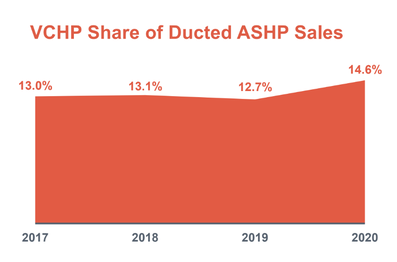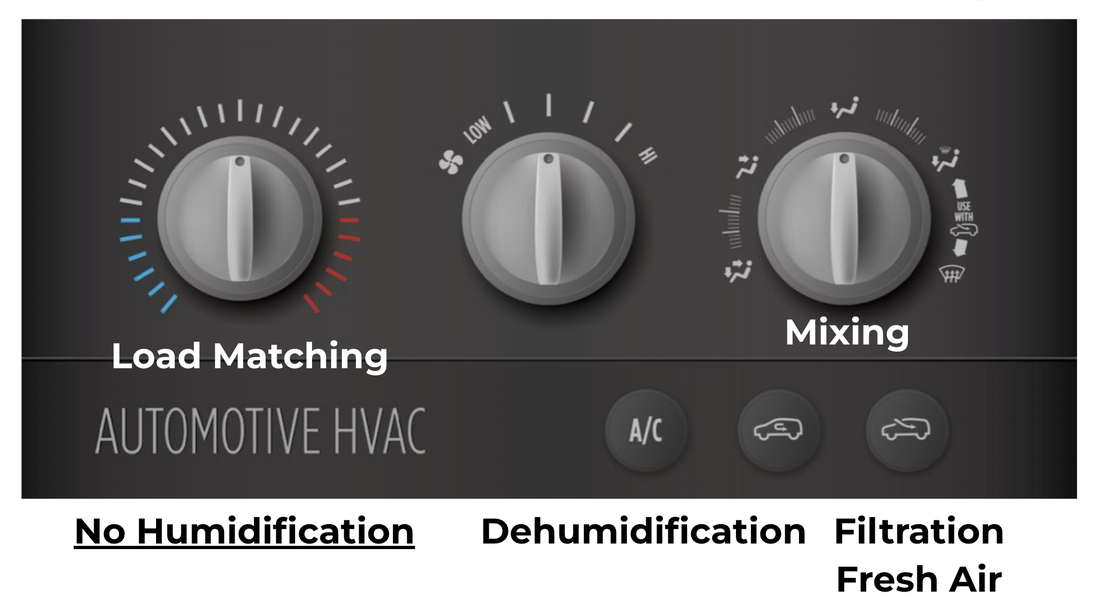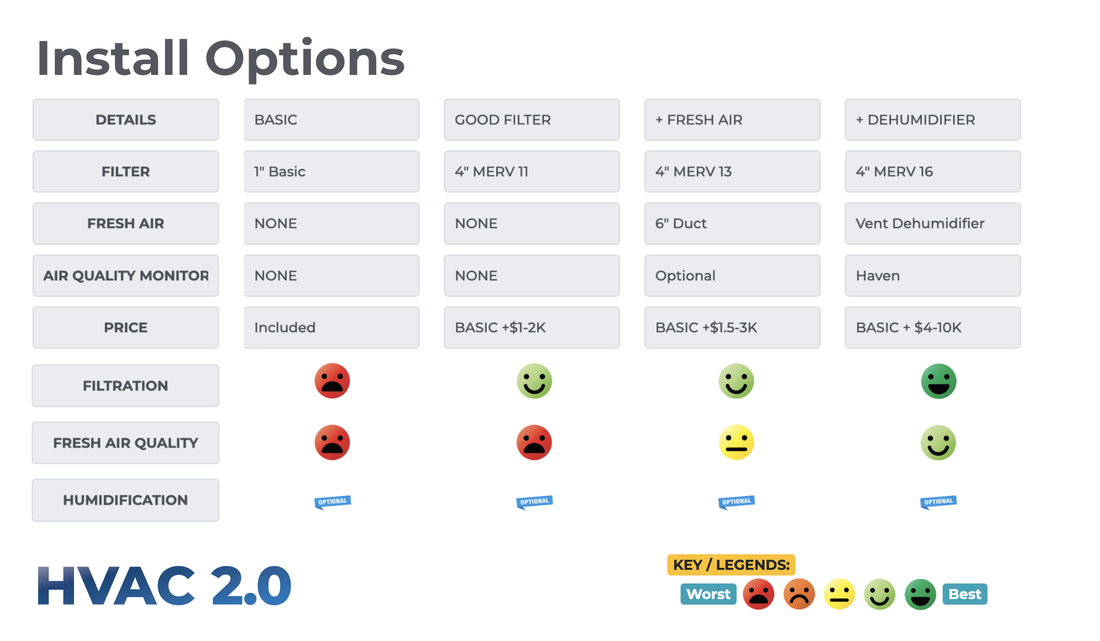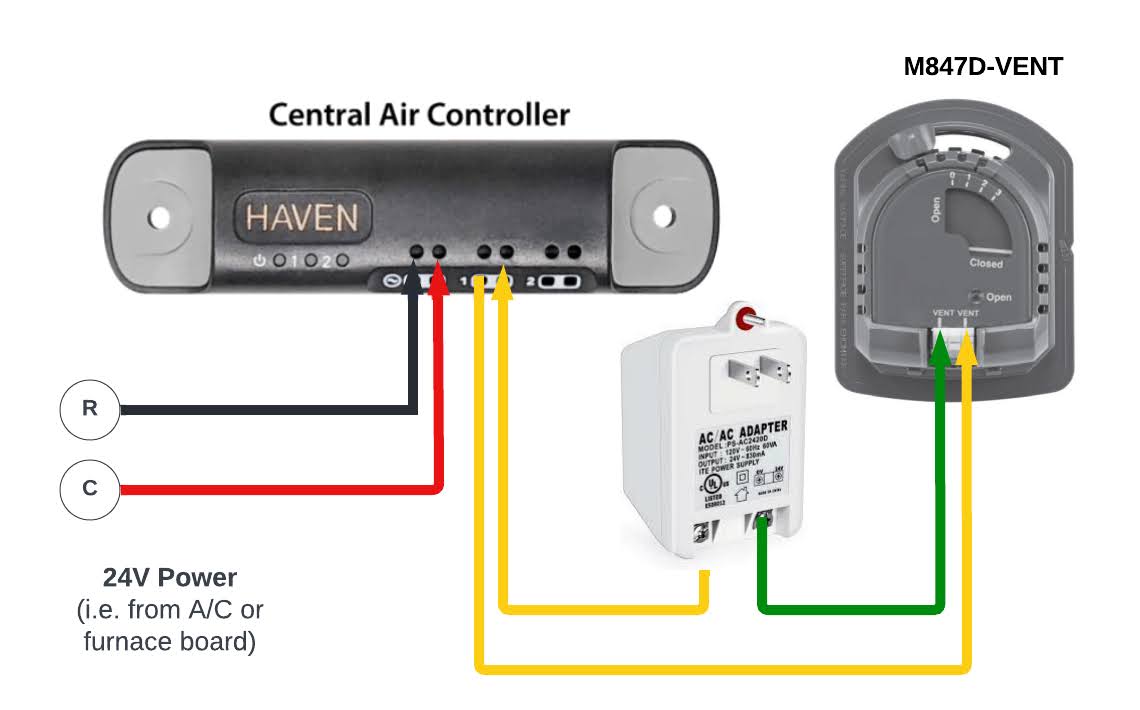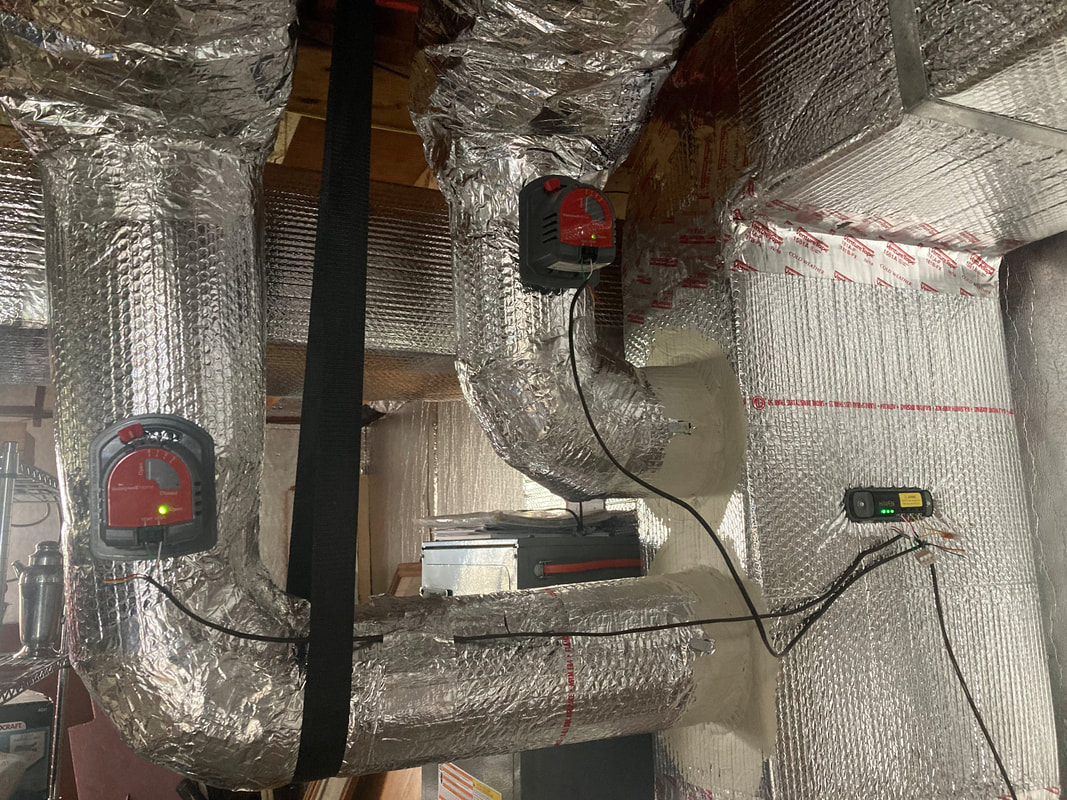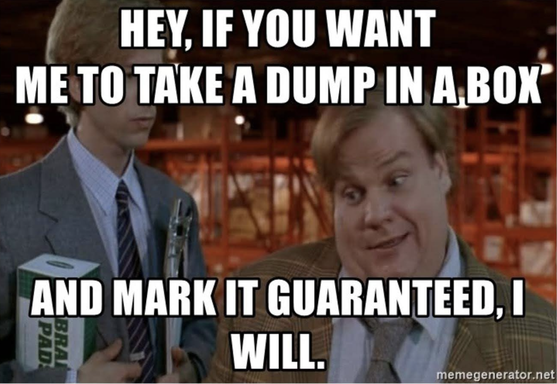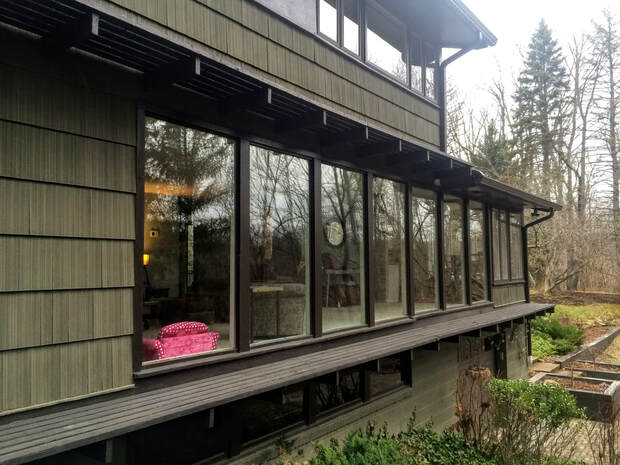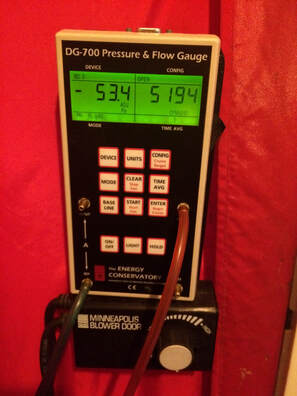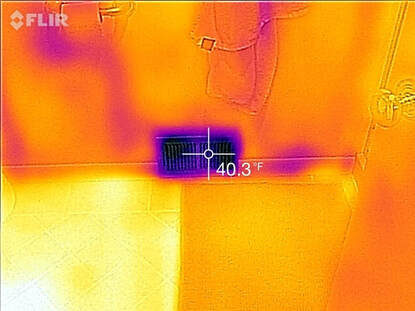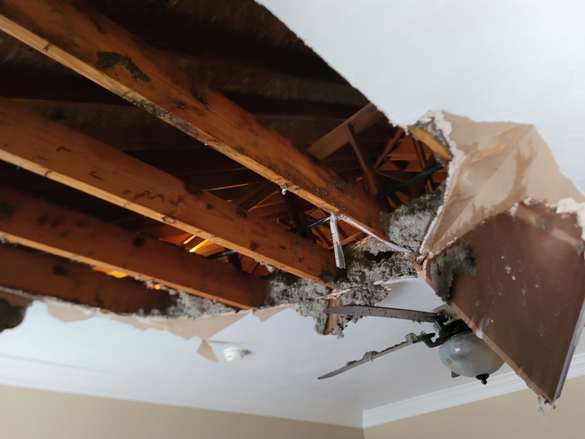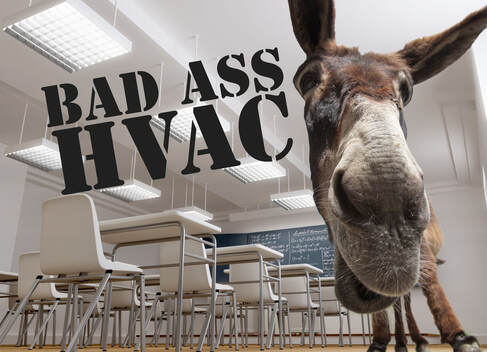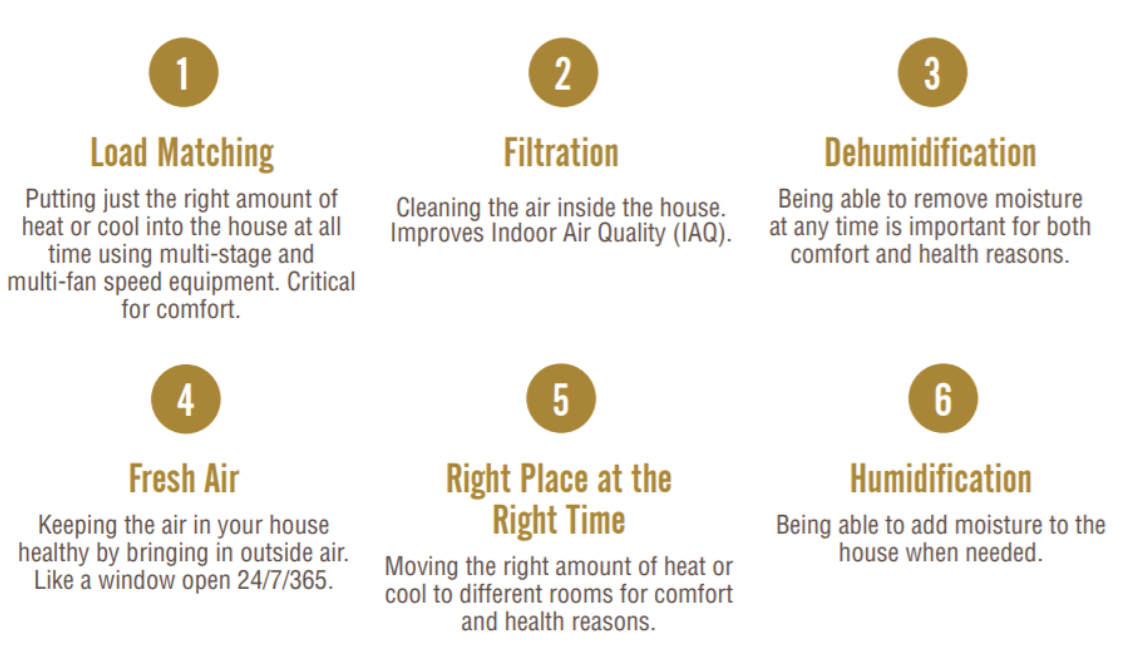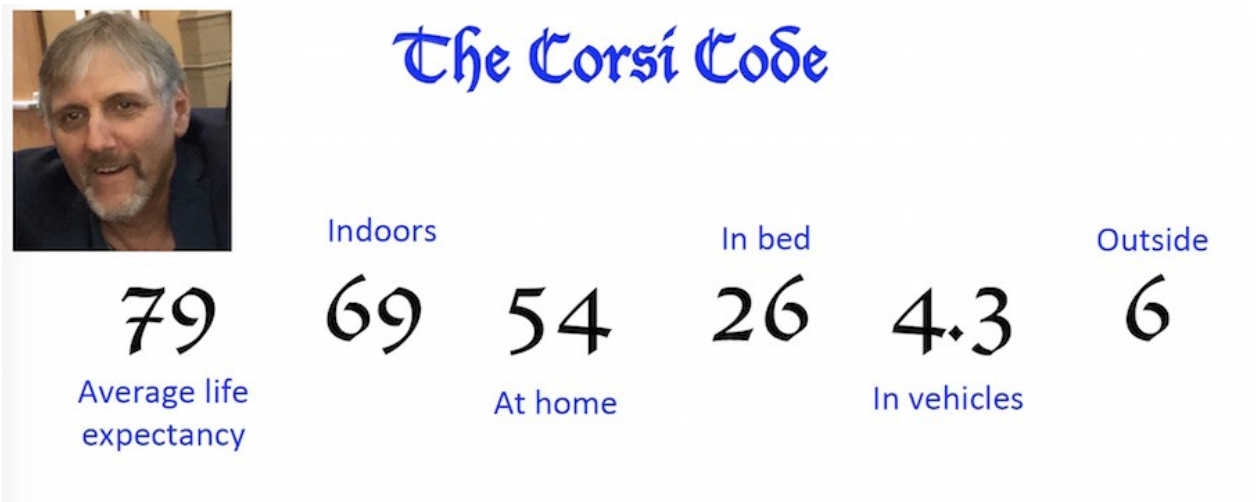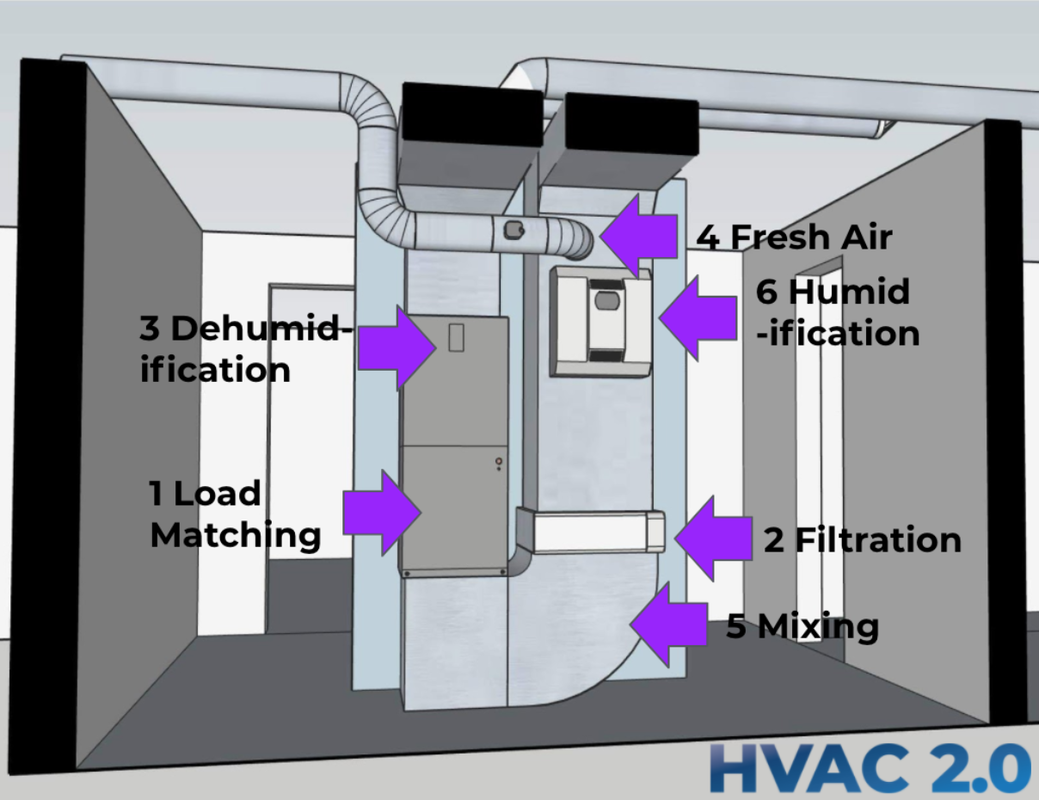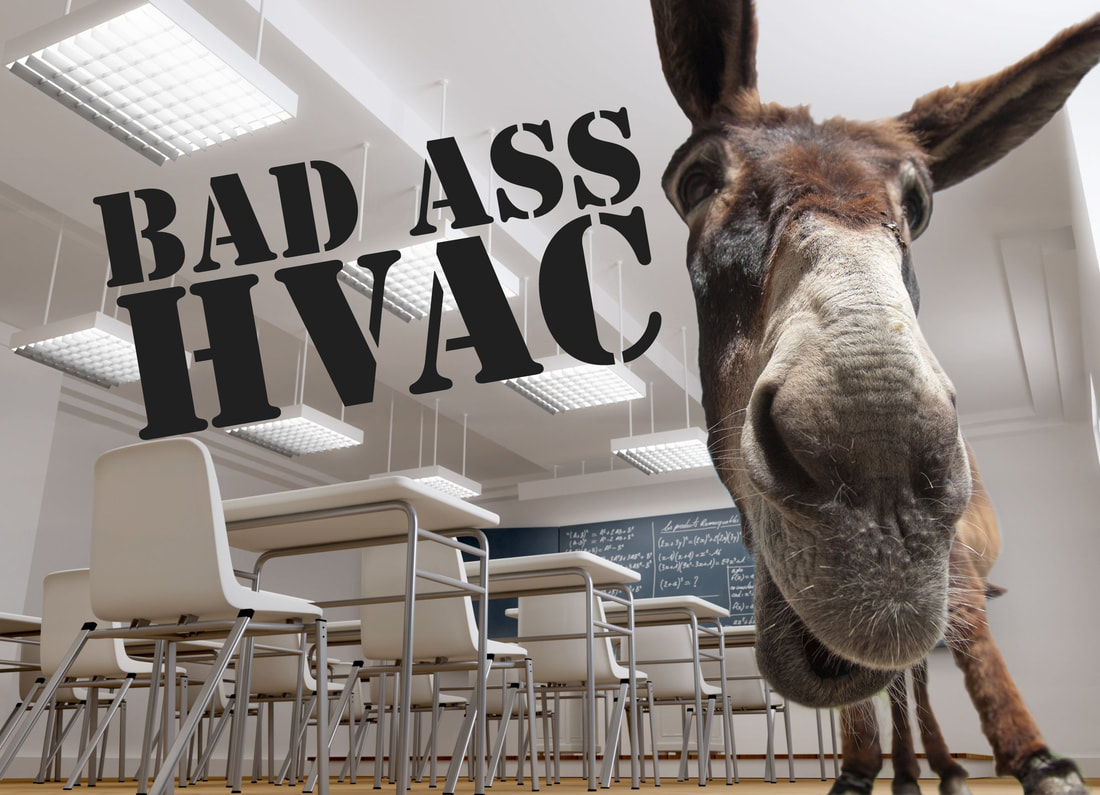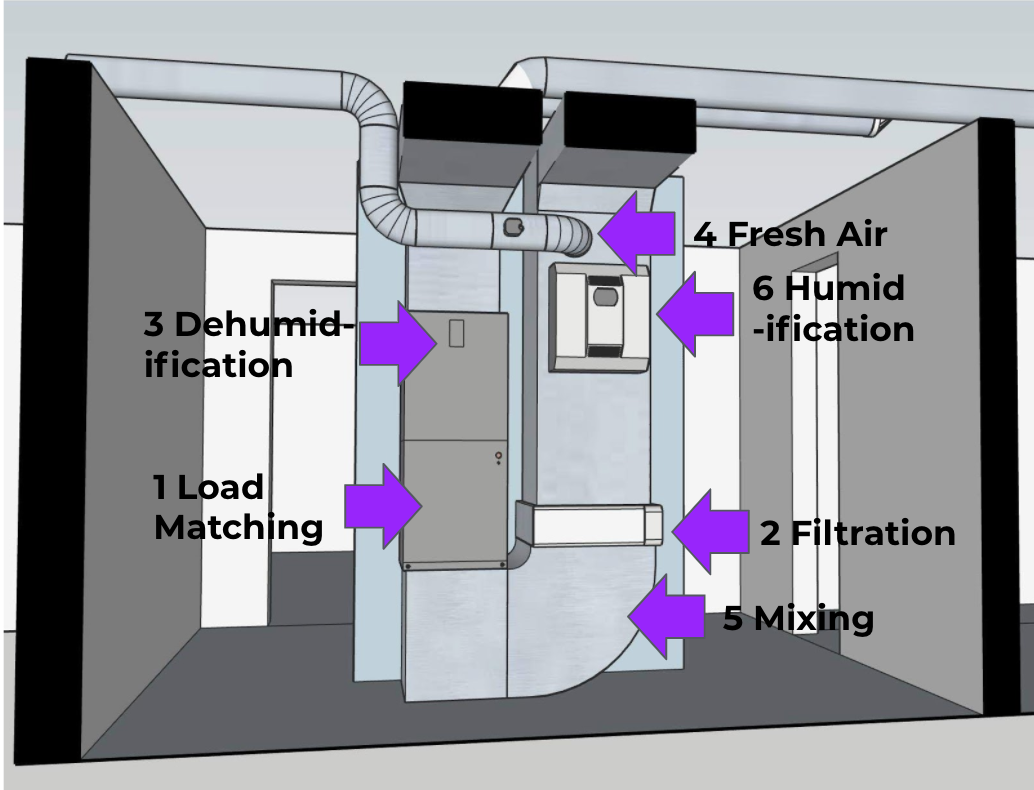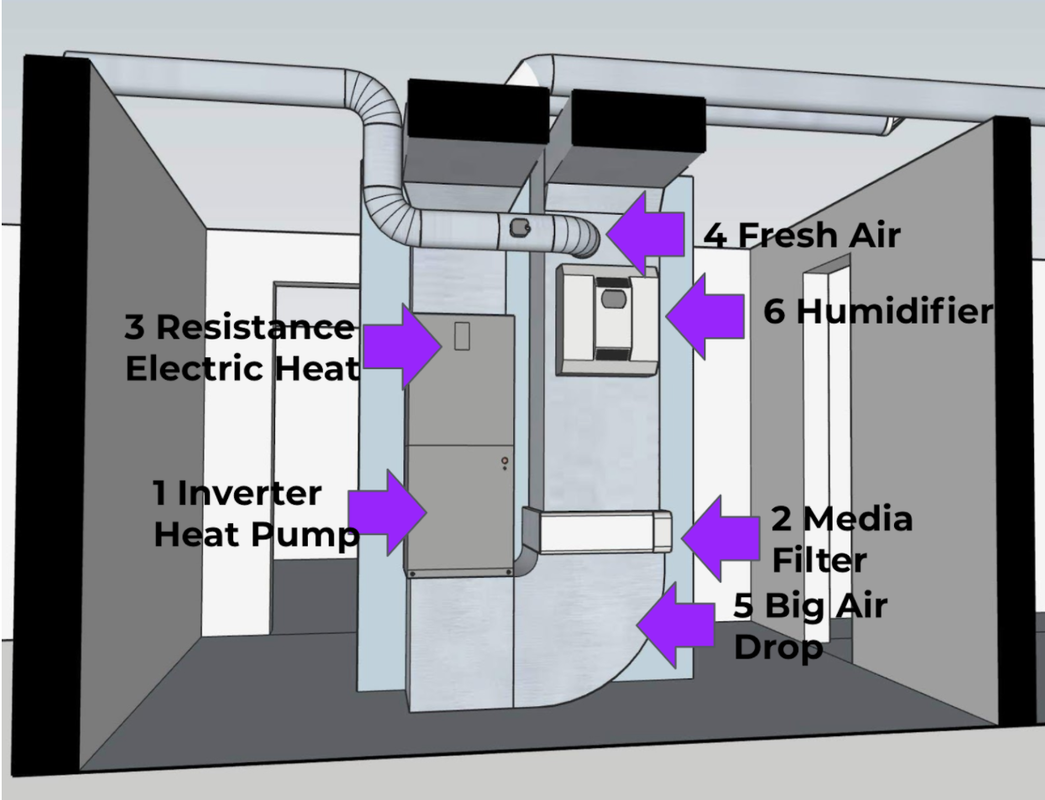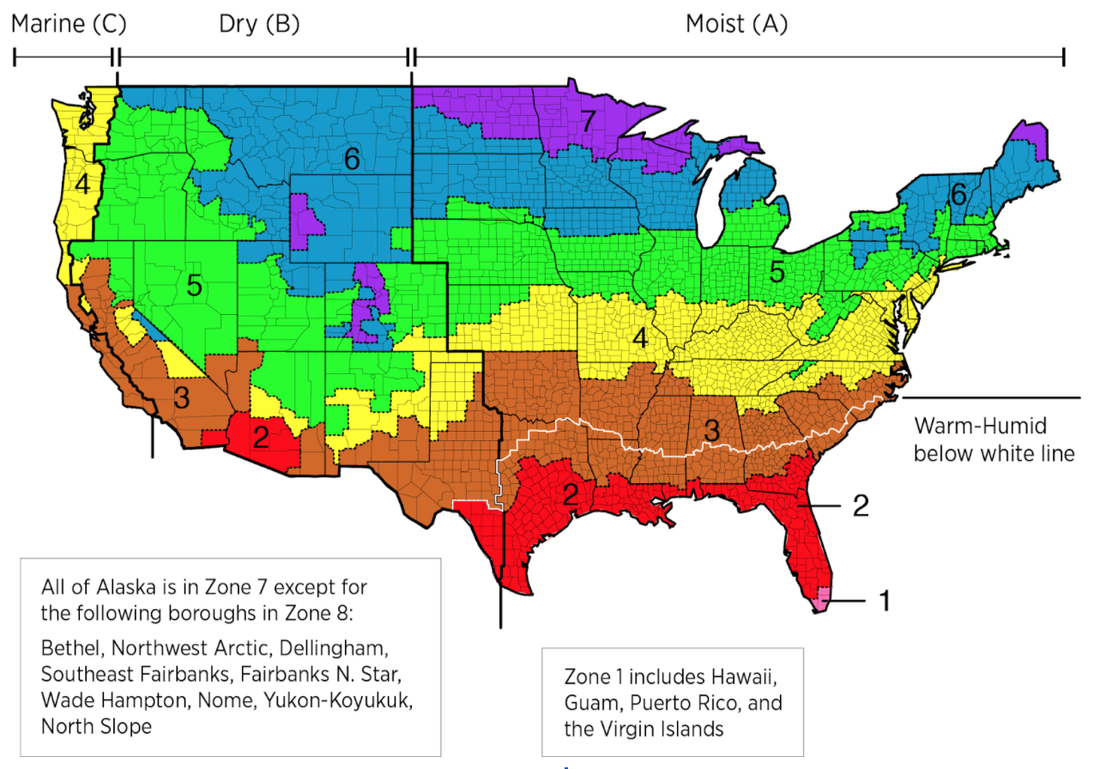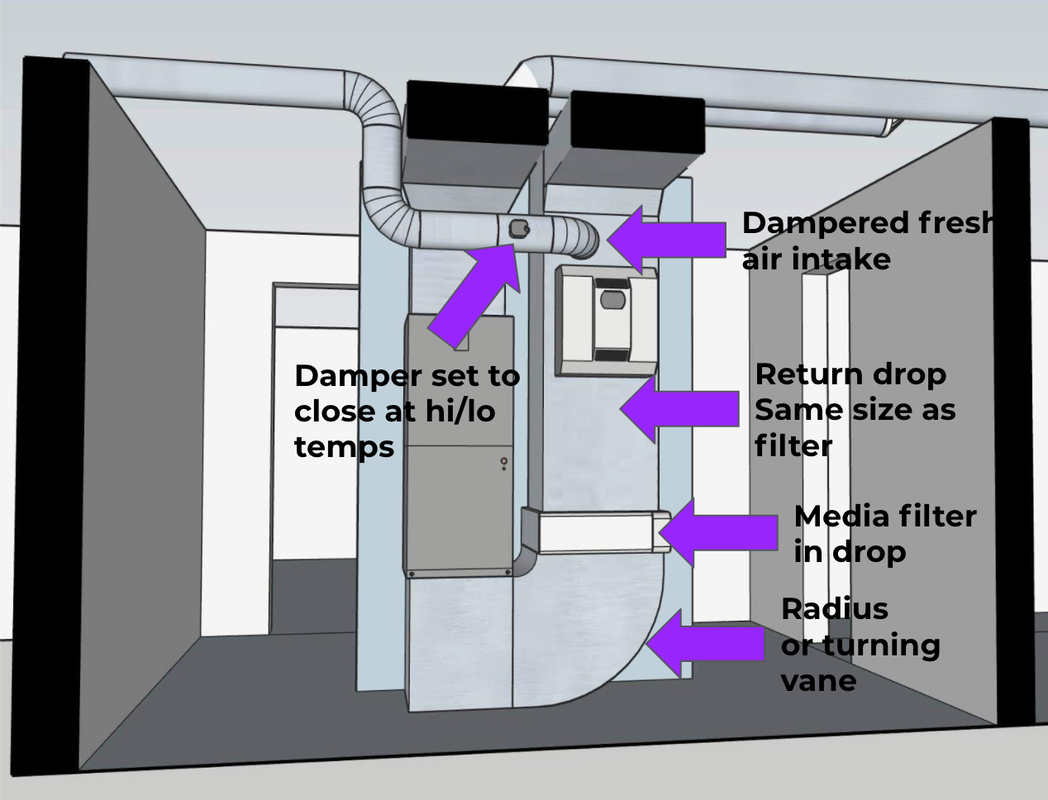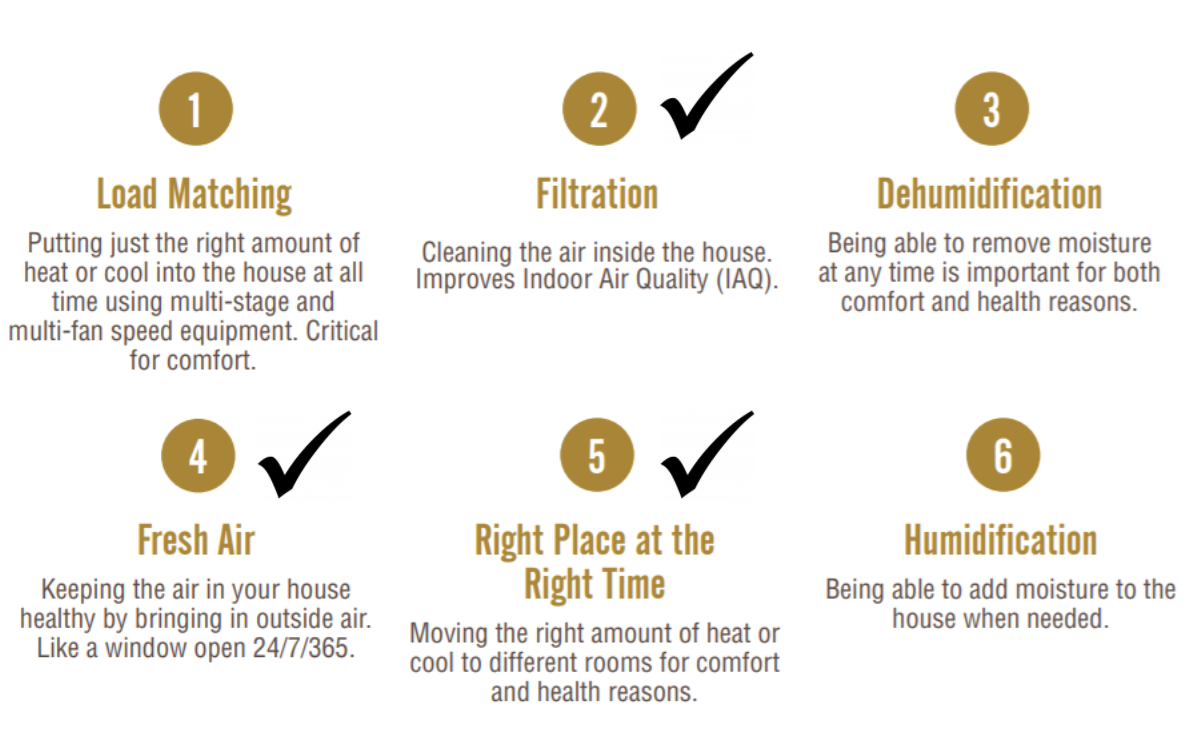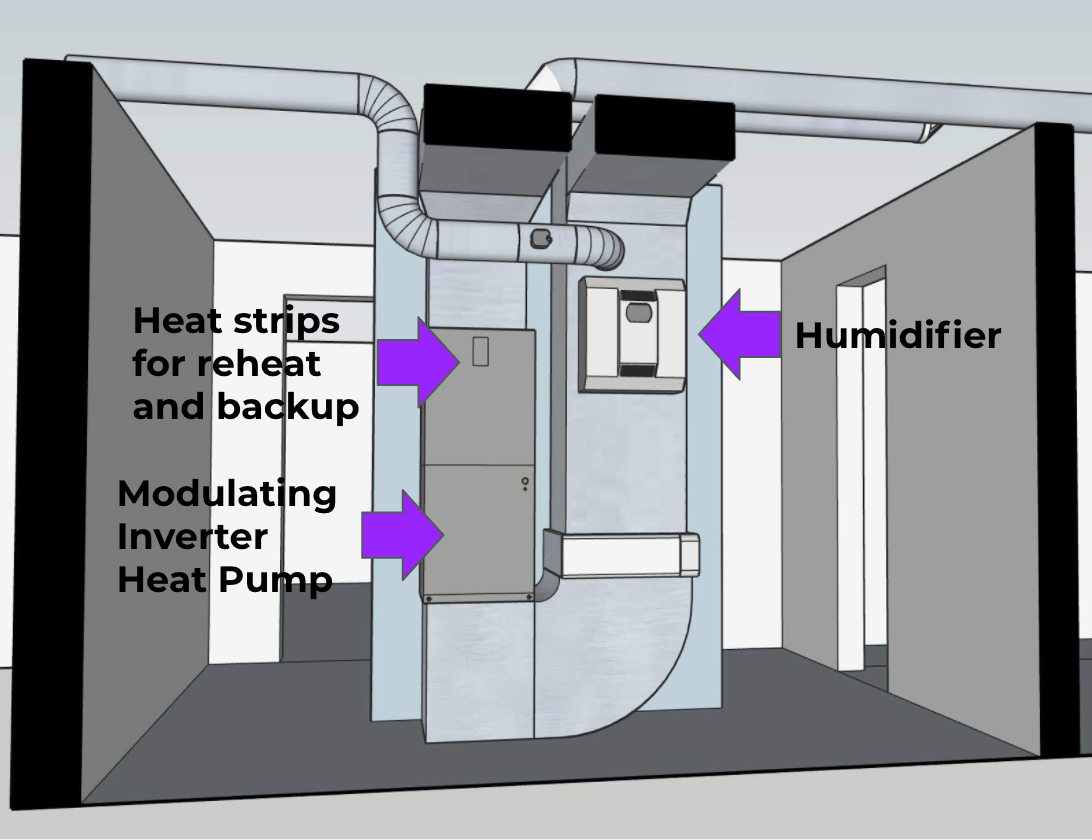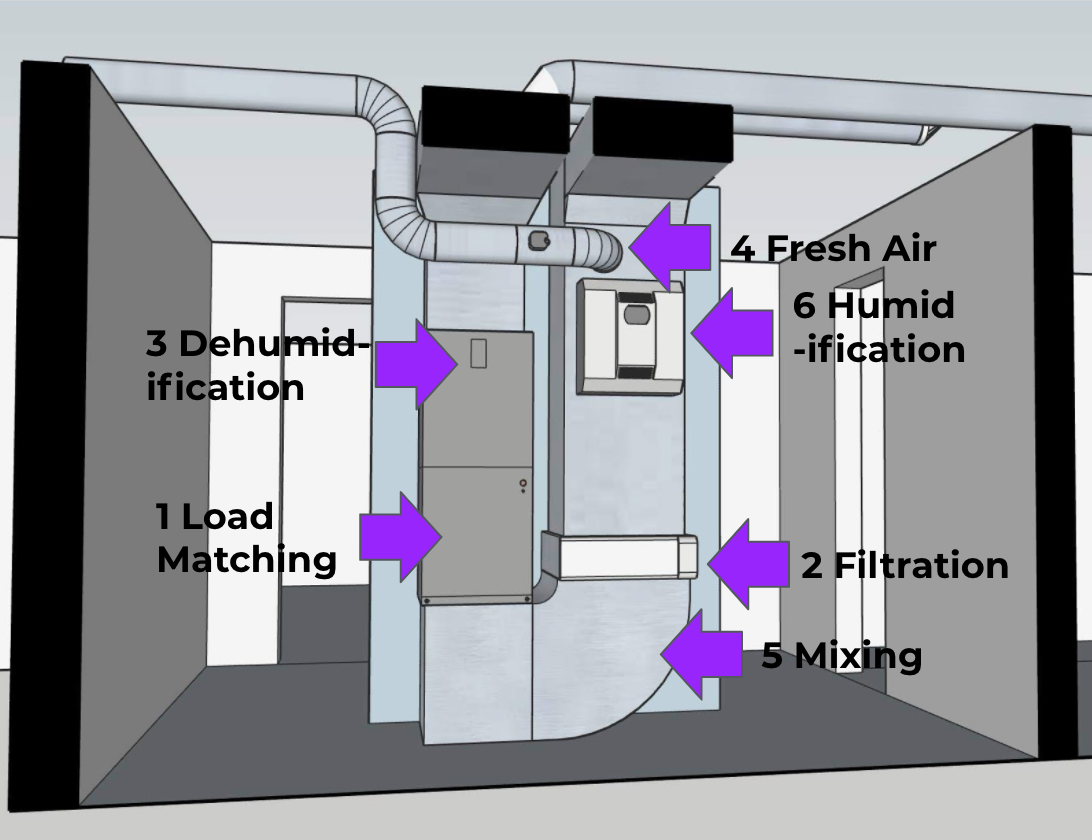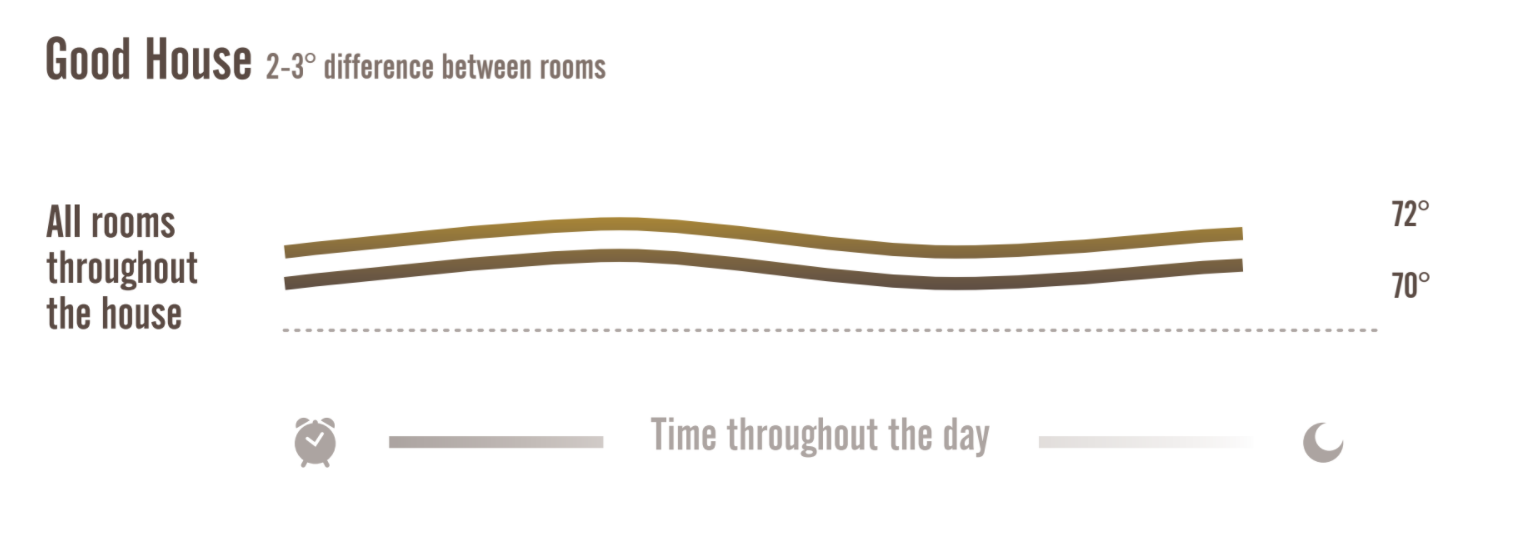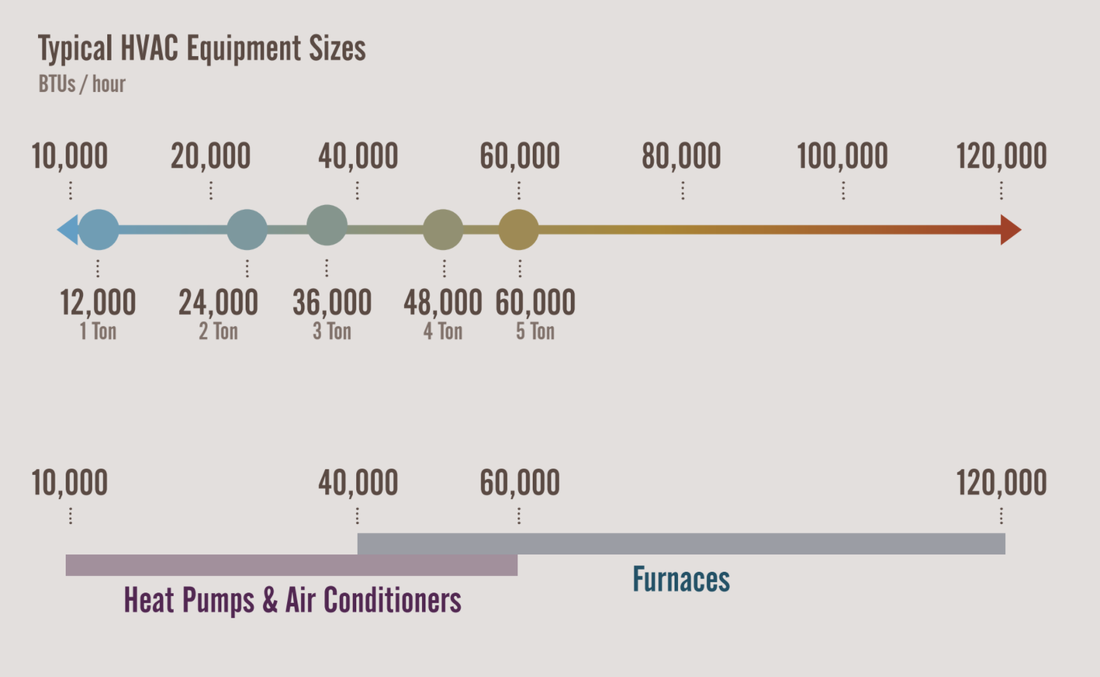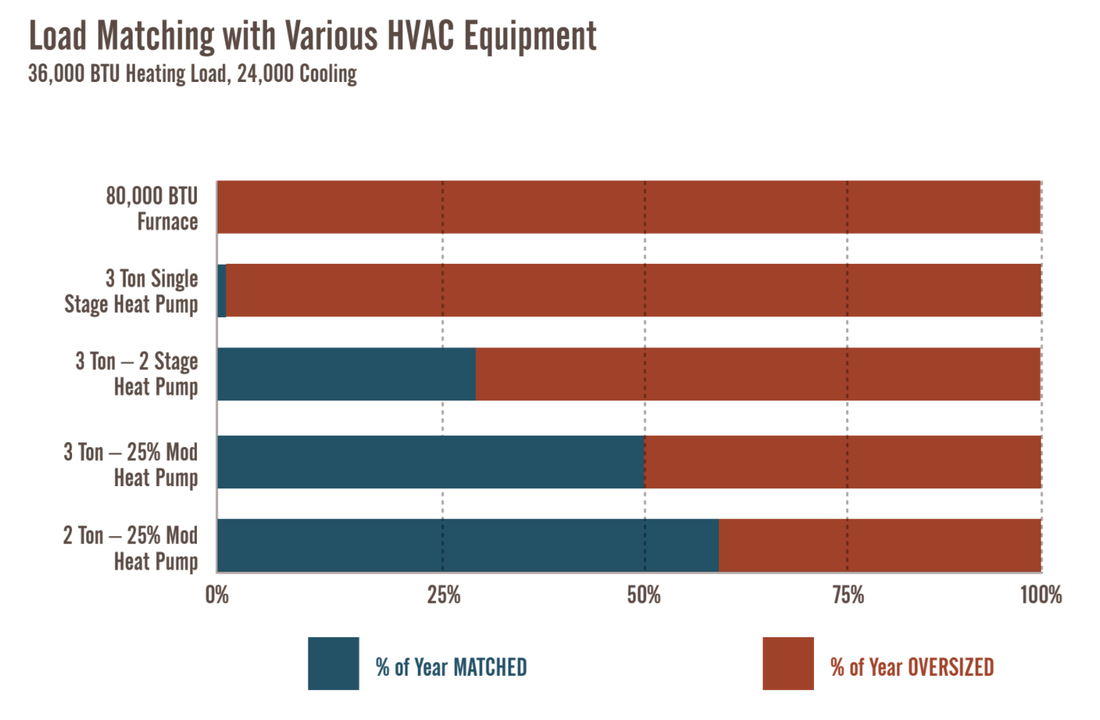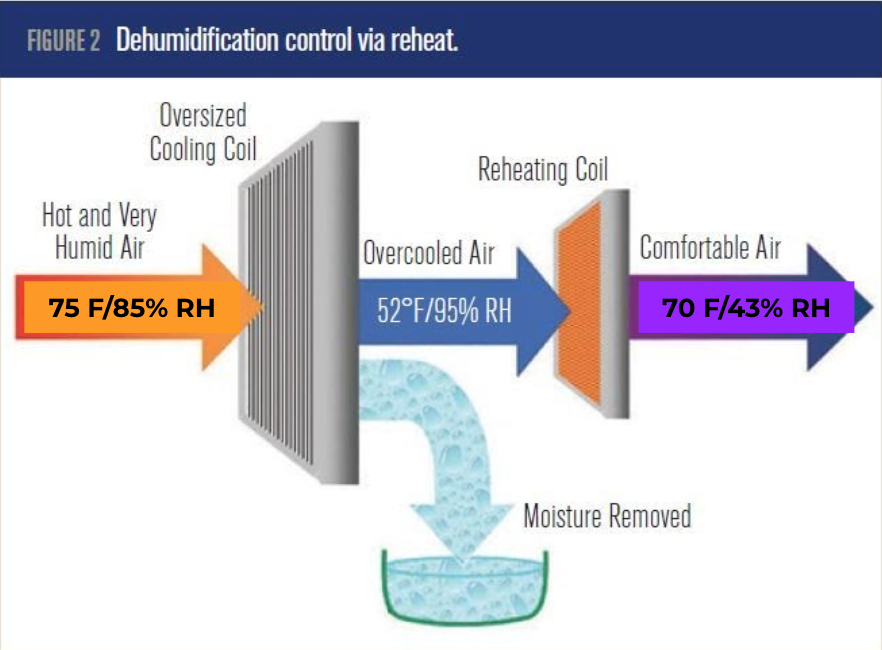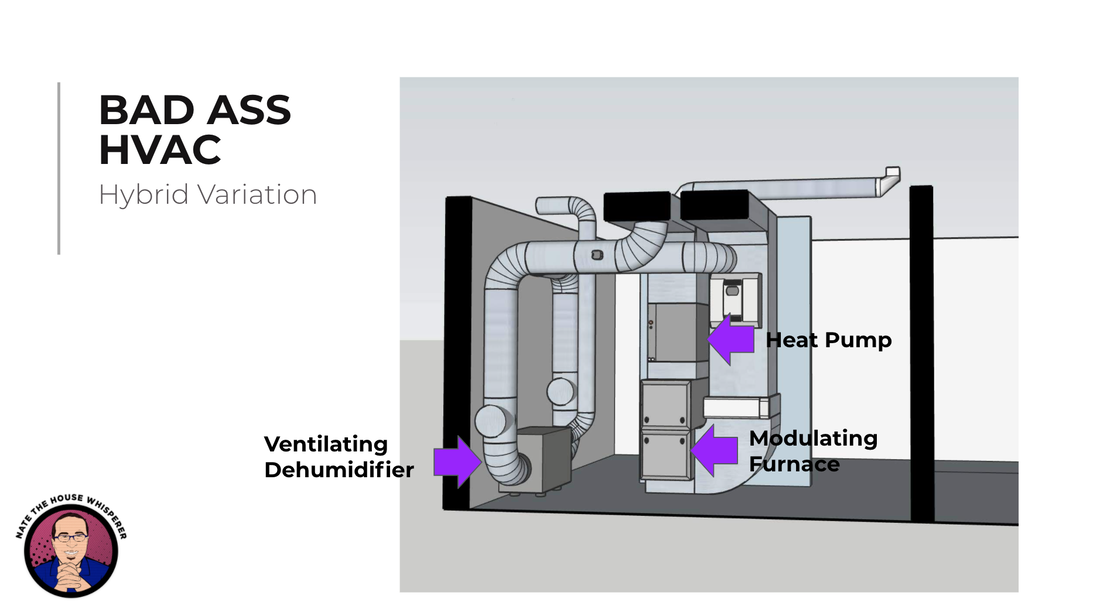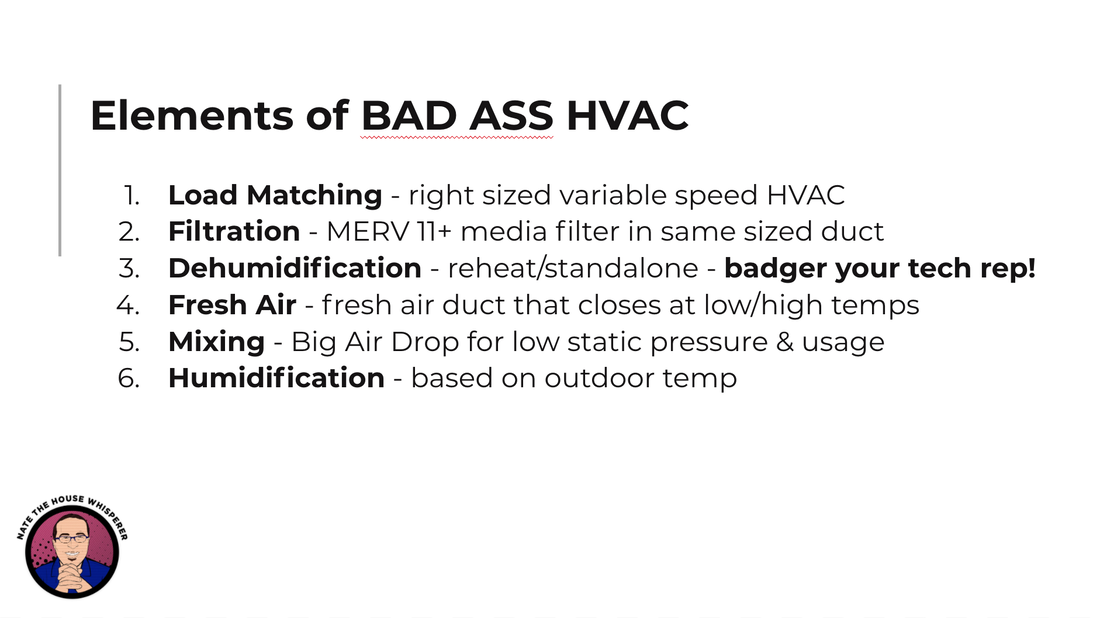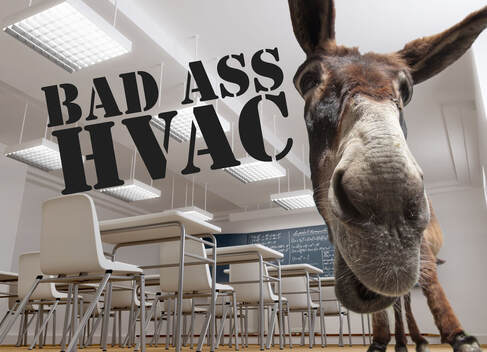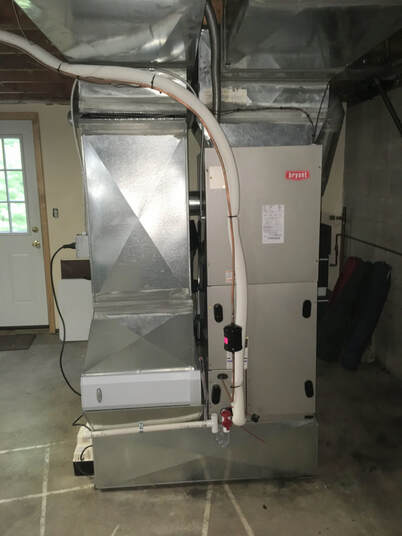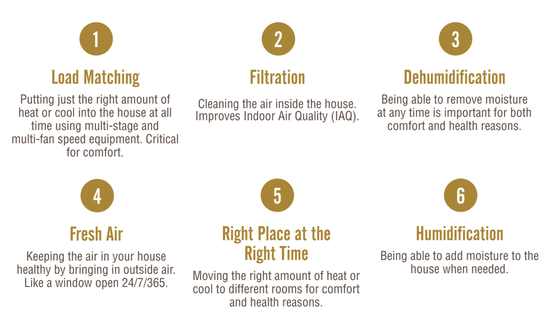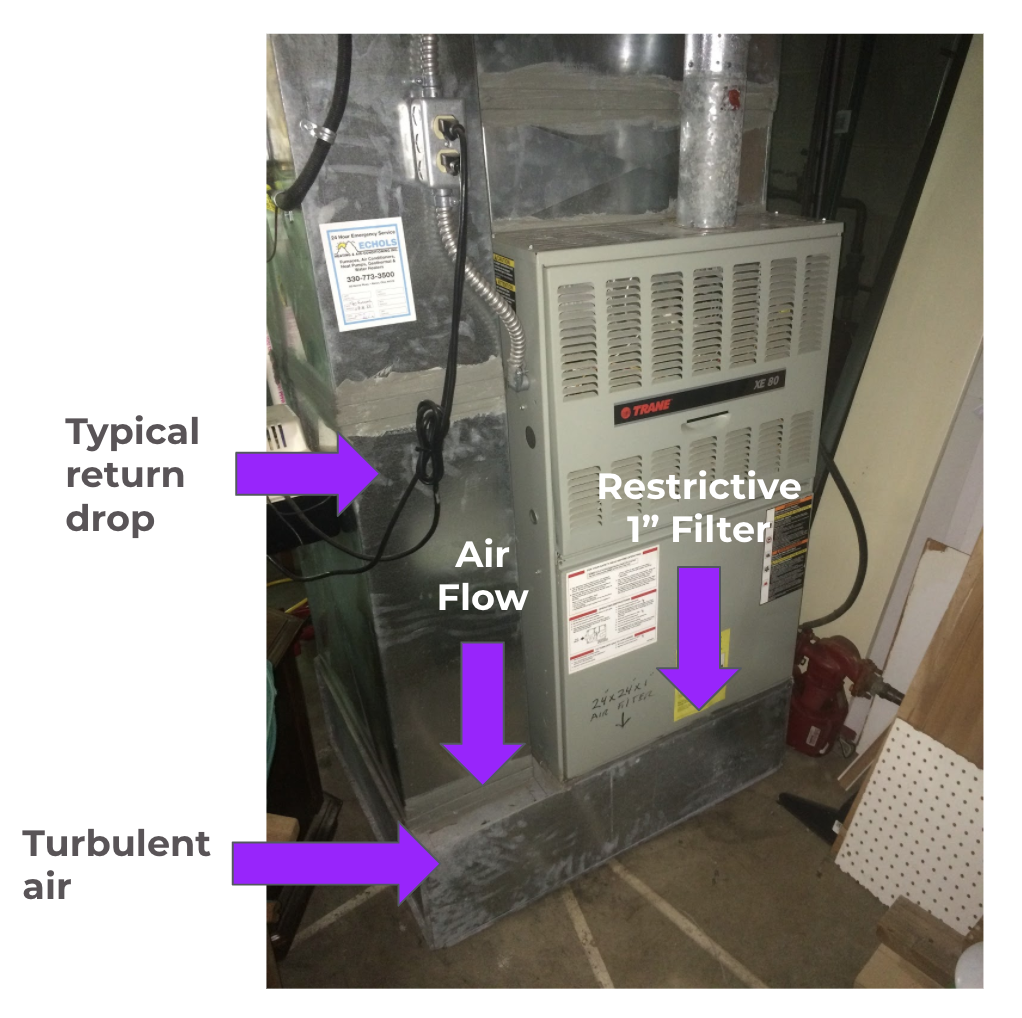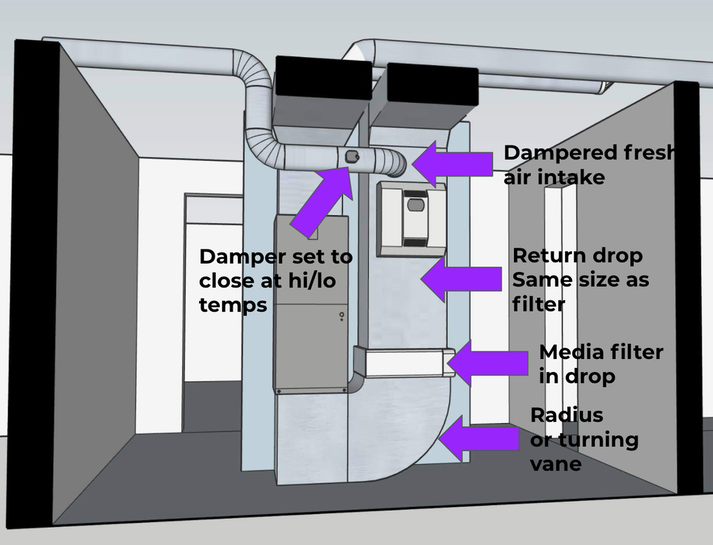|
According to private industry meetings with multiple HVAC manufacturers, about 85-90% of residential HVAC (heating, ventilation, and cooling) replacements are emergencies. This strongly correlates with our boots on the ground experience. Failures usually happen on a hot or cold day when the stressed out system finally fails. This makes sense because buying a new furnace or air conditioner is one of the least sexy ways to spend money, yet it’s one of the most expensive purchases we make behind our homes and our cars. It’s also a big missed opportunity as we’ll see in a minute. Naturally, when hit with a large unexpected expense, we seek to minimize it. Remember that 85-90% figure? Statistics are hard to come by, but about 85-90% of residential HVAC systems are basic or mid efficiency units. VCHP = Variable Capacity Heat Pump The Bonneville Power Administration in the Pacific Northwest laboriously tracked residential HVAC equipment sales and found that only 13-15% of HVAC purchases were variable capacity equipment. Could those two 85-90% numbers be related? We sure think so. An Expensive Missed Opportunity Buying basic equipment is a major missed opportunity, because better systems can provide remarkably better comfort and indoor air quality. In the HVAC 2.0 Contractor Network, we consistently hear from clients how amazing their house feels now vs with the old HVAC system. One of my clients commented to me that “you put invisible radiators all over my home!” She couldn’t believe how much more comfortable her home was after switching from an oversized single speed furnace to a variable capacity heat pump with a good installation. We call the system we installed for her "Nearly Perfect HVAC." There are more things you can do still but it's nearly perfect, and typically far beyond client expectations. If you’re buying a new HVAC system, getting these benefits doesn’t cost what the great system does, it only costs the difference between the basic and the great system. If you choose poorly and buy a basic system, only to be disappointed by the results, the only way to upgrade is to replace the system again, throwing out the recently bought system. That may sound hyperbolic, but we see it quite frequently in the HVAC 2.0 Contractor Network, and it’s painful for all involved. We’d much rather help clients make better decisions up front. Car HVAC vs Home HVAC So what gets better? The easiest way to understand the opportunity is to think about the heating and cooling system in our cars, which is pretty amazing, they tackle 5 of the 6 Functions of HVAC:
Getting These Isn’t That Hard There are many home HVAC systems that can provide those capabilities, it’s simply a matter of choosing the right equipment and install for your home and situation. 3 of the 6 functions are directly related to what system you choose, the other 3 are related to the install itself. Here’s a look at what it takes to get the 6 functions. A hybrid is a furnace plus a heat pump rather than a furnace plus an air conditioner. They give you more and lower stages of heat to provide better comfort. A heat pump is what we jokingly call a "bisexual air conditioner" - it can cool and heat, it goes both ways. Check out the various equipment and install options below, you can pick and choose what’s important to you, but now you'll have a better idea of how to get your home HVAC to be as awesome as it is in your car! 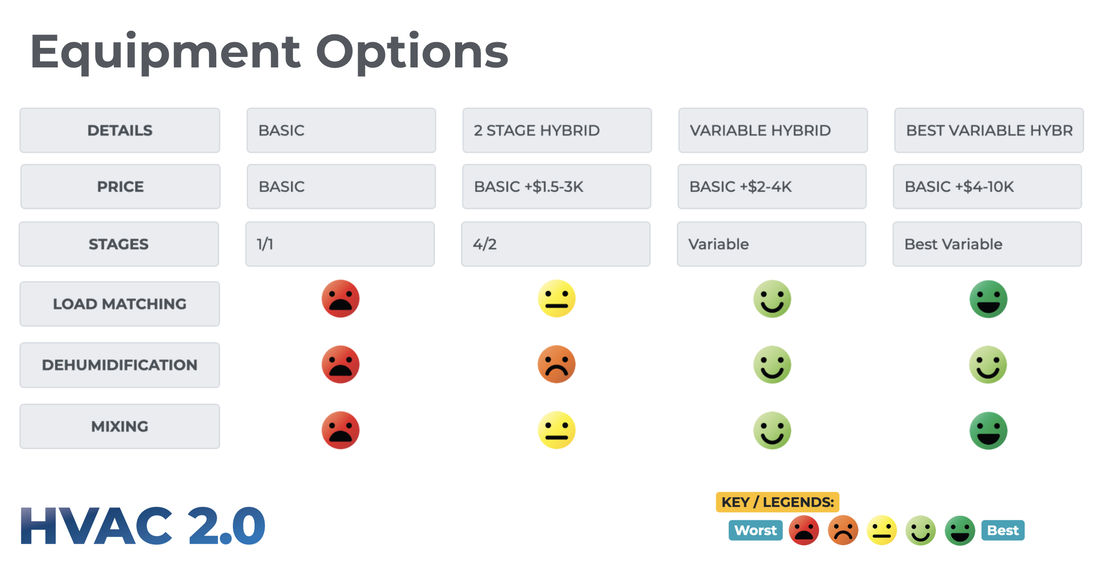 Middle of the Road Buys a Lot!
Note that going with midrange equipment, a better filter and a fresh air duct get you most of the benefits for marginally more than a basic system. We call the top of the line system Nearly Perfect HVAC - we find it does an excellent job providing good comfort and air quality. Not always perfect as the house may need some insulation and air sealing work, or another piece of equipment may be needed for perfection, but enough so that our clients almost invariably say "I can't believe this is the same house!" If you’re facing an emergency install, ask your HVAC installer about these items, or if you’re lucky enough to have one near you, your HVAC 2.0 contractor will help you with these as a matter of course. I hope this has been helpful to you, and please don't miss the opportunity to make your home much more comfortable and healthy! Want more?
You may have noted that I haven’t written anything about air quality monitors in a long time. Why? I was frustrated that there wasn’t a product that had the attributes I wanted, and also that there wasn’t a product that could do anything when pollutant levels justified action. That has completely changed recently with the Haven central air quality monitor and controller, which can actually take action from what it measures, and it offers the feature list I’ve been looking for. We’ve installed them in several of our AirBnbs, this column will look at how we came to that conclusion and how it’s going early in the experiment. But first, let’s take a step back a few years and look at air quality monitors. IAQ Monitor Must Haves After spending a bunch of time with 7 air quality monitors in 2016 to try and learn what they’re capable of and which ones were better than the others, I came up with a list of 3 things that are must haves to deploy these in client homes:
I really didn’t think this list was that hard to meet. Yet since the Foobot went off the market a few years ago, no room monitor actually met all of these. While there are plenty that are good for one off applications, none were a good fit for a pro who wants to monitor multiple homes with ease. Frankly I gave up on monitors. We’d learned enough to come up with the BAD ASS HVAC design, which does a pretty good job automatically controlling air quality without any sensors or actually turning things on and off when a pollutant gets too high. Essentially, I gave up on the dream of truly controlling IAQ and moved on with my life. Enter Haven Having tried and eventually written off all room air quality monitors because they were lacking one of the 3 things above, I heard about the Haven Central Air Monitor. The Haven Central Air Monitor is different, it goes inside the return duct just before the filter. At first I didn’t like this about it, I’d grown used to room monitors. They have their own proprietary PM2.5 sensor that has remarkable accuracy in the lab. It measures 6 things:
Note the four things I want to be sure to measure are in there - temperature, humidity, PM 2.5 and tVOC. They also have a dashboard and their readings are generally quite good. I have a struggle with two of their humidity sensors, but the others have been on point, and most importantly the PM and tVOC sensors match events that I know of - cleaning, cooking, painting, etc. Room vs In Duct Monitors There are two big problems with room monitors: clients unplug them eventually, and the sensors get dirty and out of calibration after a year or two. While at first I didn’t like the sensor being inside the duct, that placement solved the customer unplugging them because the light annoys them. They can’t see it, it’s out of sight, out of mind in the attic, basement, garage, or crawlspace. The sensors are easy to clean with a Q-tip or similar when changing filters and doing easy maintenance, solving the other main issue with room sensors. So the Haven solves the two primary weaknesses we found in in room monitors. I was intrigued. I now know most of their team, they are highly focused not just on selling products, but actually solving problems, and they also value technical excellence. But there was still a problem. The Car Alarm Conundrum Have you ever heard a car alarm going off in your neighborhood and thought “why don’t they turn that thing off?!” That’s essentially what indoor air quality monitors do - they tell you there’s a problem, but they can’t solve it. Basically they are annoying without offering a solution. In the commercial world there has been “demand control ventilation” for years that monitors pollutants like carbon dioxide and can turn on devices to solve the problem. For homes we haven’t had a solution - until Haven came out with their central air controller last year. The Haven monitor talks to the controller when something is amiss with IAQ. Each controller has two dry contacts you can use to turn on the equipment of your choice. You can use multiple controllers with one monitor, so you can control 4 or even 10 different devices if desired. Conundrum solved? Trying It Out: Haven + BAD ASS HVAC Being an early adopter, I wanted to try out the controller with my monitor. This is something I wanted to try in one of our homes though, it’s early enough that I didn’t really want to try it with a client in case something went wrong. We recently moved to Fayetteville, West Virginia near the New River Gorge National Park. We bought two little houses next to each other (700 and 800 square feet.) We themed them, one is the Game House with board games and the other is the Candy Cottage which has a Willy Wonka feel. The Game House is done to the AirBnb specification I proposed in this column late last year - the bath fan and range hood are both vented outdoors, it has BAD ASS HVAC (with a standalone small dehumidifier for dehumidification), and a 14-50 plug for EV charging. I still need to figure out how to show guests what their air quality looks like. They both got 1.5 ton Daikin Fit heat pumps (another thing I wanted to try out.) The Fresh Air Strategy of My (Very Realistic) Dreams Dr. Joe Lstiburek has talked about bringing in 50% of ASHRAE 62.2 guidelines all the time, then ramping up to 150% as needed. I really wanted to see how that might work in the real world. For a long time we’ve wanted to try out two fresh air ducts, one open almost all the time, and the other open when tVOCs/CO2 got too high. I’ll write about fresh air strategies soon, so for now please suspend your arguments in your mind about supply only, exhaust only, and balanced ventilation. These homes have a supply only strategy. In each of the houses, I had two 6” ducts run from the HVAC return to outdoors, each with a motorized damper, see the photo. Our preferred fresh air control strategy is to bring in a small amount of outdoor air (10-30 cfm) all the time, except when it gets very hot or cold. In Cleveland I usually set a Ranco controller to close the damper above 80F and below 20F. At those temps stack effect helps take over for bringing in a bit of outdoor air, and the temperature seldom stays below/above those temps for more than 12 hours. In measuring airflow from 6” outside air ducts into returns, they typically bring in 10-30 cfm on low fan speed and 30-70 cfm on high. It mainly depends on how short the fresh air duct is, how close the duct is to the filter, and how much negative pressure is in the return plenum. Setting Up the Haven Controller In each house I have two outside air dampers to control. The software for the Haven controller is still a bit early, so don’t expect perfection. I’ve known most of the team for years now, they have a strong drive towards excellence, so I trust that they will get any bugs worked out over time. Presently they don’t have a way to control a motorized damper, but Graham in tech support created a wiring schematic for me to make one work. Since there is no program for dampers yet, I had to game them by calling them something else:
My overarching strategy here is to keep tVOC/CO2 levels reasonable when these small homes are fully occupied, which is 6-7 people. Our neighbors have commented how the air feels and smells fresher than they are used to, so it appears to be working. The Good The good news is that the controller absolutely works. I love popping into the basements of these two homes and seeing dampers activated. The tVOC levels consistently stay low, which by proxy means the CO2 levels are low too. I’m thrilled with this! It’s working! This is a game changer because now we don’t have to just install a passive system for IAQ, we can get active with it. You can install multiple controllers too with almost not limit Other Control Strategies I’m not using many of the strategies that Haven is offering such as:
The Bad There have been a few challenges:
For an early product, those are just nits. A Big Step Forward Like I said in the beginning, I’d given up on a) an IAQ monitor that met the requirements I thought were reasonable and b) could actually control things to make IAQ better. Then Haven showed up with their products and made the impossible, possible. Will this be for every client? Of course not. Most won’t care. It will require both monitoring and having some idea what to do if there is an IAQ problem to solve. Unlike throwing a UV light at a client and assuming it’s working, solutions actually have to work. Those things aside, for those of us that truly like to solve problems and see that they are solved, this product gives us an option to do that with an inexpensive solution for our clients. Can AirBnb and VRBO Help Scale Residential Electrification and the #ElectrifyEverything Movement?11/15/2021 If you’ve read my work for a while, you know I’m into electrification - it gets rid of combustion indoors which is generally good for indoor air quality, and it allows homes to run on clean electricity which is good for outdoor air quality. Done well it also creates the most comfortable homes I’ve ever been in. It also readies us for a renewably powered future, as solar and wind paired with batteries are now the cheapest unsubsidized energy source mankind has ever known. But we have a problem: HVAC contractors (especially in cold climates) and homeowners are often nervous about electrification. In many cases with good reason, old school single stage heat pumps don’t deliver the best experiences. They’re known for cold air blowing very quickly out of vents, noisily ruffling curtains and making occupants uncomfortable when they get hit with cold air. Part of this is lack of commissioning, but much of it the limitations of single stage (and two stage) technology. (For more on HVAC types read the free HVAC 101 guide.) Modern inverter driven heat pumps have totally shifted that equation - they’re quiet, blow much warmer air, and can provide far better comfort than either old school heat pumps or modern furnaces thanks to being able to load match (see BAD ASS HVAC part 1). Doubting Thomases Now we hit another problem, as humans we tend to be doubting Thomases: we want to put our fingers in the proverbial hole in the hand. We need to experience things before we believe and internalize them. How can we provide this experience so that more consumers are inspired to do it themselves? The answer may be quite simple: create an #electrifyeverything class for short term rentals from services like AirBnb and VRBO. Then let consumers experience the superior comfort and air quality by trying homes out that are short term rentals (aka AirBnb, VRBO, etc.) and have been electrified. AirBnb and other short term rental services provide far higher cash flow than long term rentals, so they allow going above and beyond what you would do for a long term rental. A typical long term rental will cash flow $100-500/month (I’m sure CA is an exception, but these numbers hold for “normal” home value areas.) Short term rentals can easily cash flow $1000-5000/month depending on home size and how much is borrowed. You may not know this, but my wife and I have been AirBnb hosts for years going back to 2015. We really just dabbled when we knew a bad income month was coming (building HVAC 2.0 hasn’t paid well!) But then we decided to travel during COVID, bought a camper, and put the River House up on AirBnb. It surprised us by netting us $1000-2000/month after all expenses, which helped pay for our trip. It also inspired us to buy a second home in Fayetteville WV very near the New River Gorge National Park with the intention of renting it most of the year as an income property. Then we realized that we love it so much here that we decided to move and instead rent our Ohio home most of the year. Now we’ve bought two more small houses to convert as well. Both need a good deal of love, love that they would be unlikely to get as long term rentals because the math just doesn’t work to do more. The Solution? Which brings us to the solution I alluded to: AirBnb and VRBO could create an #electrifyeverything class of properties. As much as I hate rules because they tend to be a cause for pencil whipping and unintended consequences, I don’t want to see someone throw in a poorly installed single stage heat pump and stamp it guaranteed. So I propose four rules:
Those will naturally lead to inverter driven heat pumps, better comfort, and better air quality while being fairly easy to achieve. Because short term rentals have higher margins, it opens up room for these sorts of upgrades, particularly if HVAC in a property is at end of useful life. Did you notice that I am not talking about shell measures here? If an owner is ok with high energy bills and potentially poor comfort in a home that is supposed to be comfortable, the reviews and energy costs will naturally drive that work to get done. Huge Leverage A few thousand of these around the country could host 50-100 families each per year and give them the #electrifyeverything experience. Say there were 2,000 properties that host 50 families a year each. That’s 100,000 families a year seeing what the hype is all about. That is likely to spark many more full or partial electrifications and likely more #electrifyeverything short term rental properties. All of the homes would be substantially improved as well, which is good for US housing stock. These upgrades are likely to buy these homes an additional 30-100 years of lifespan by making them future proof and far more moisture resilient. We’re putting our money where our mouths are on this, by the end of 2022 we will have 4 #electrifyeverything properties complete. The River House outside Cleveland needs central HVAC but does have an UltraAire XT155 ventilating dehumidifier for filtration, mixing, fresh air, and dehumidification. Our West Virginia house recently got a Bosch heat pump, it just needs a fresh air line and it’s complete. I’m currently figuring out how to electrify the two properties we just bought. If it goes as projected by AirDna, a service that scrapes AirBnb data to help understand how homes in an area are renting and for how much, together these will create $40-60K/year of cash flow for us, enough that we don’t have to work if we don’t want to. (Although we'll likely use the money to create more of them…) And there you have it, a path to solve for Doubting Thomases, let many homeowners experience comfortable electrified homes with excellent air quality, fix up properties that otherwise are likely to be neglected, and make money for the entrepreneurs who create the properties. This could be like a brick on the proverbial gas pedal of residential electrification. It’s also a surprisingly easy thing to make happen: AirBnb, VRBO, and other short term rental services can create an #electrifyeverything class. So, what are we waiting for? If you know someone at AirBnb or VRBO, perhaps send this post to them? This position typically takes people by surprise. To be clear, I'm talking about single family homes in particular. Let's explore the details. First off, definitions. A heat pump moves heat from one place to another. Your refrigerator is a heat pump. It takes heat out of the cold air inside and pushes it into your kitchen. The source is the cold air inside your fridge, the place it rejects the heat is into your house. An air conditioner is technically a heat pump, it takes heat from inside your house and ejects it into the hot outdoors through something called the refrigeration cycle, but let's just call it magic, it's easier. An "air source heat pump" in US parlance is an air conditioner that can heat as well as cool. I jokingly think of it like a bisexual AC, it goes both ways. Sometimes silly jokes like that stick. In winter it takes heat out of the cold outdoor air and puts it inside your house. Again, think of it as magic, but it's EXACTLY what your fridge does. A ground source (aka geothermal) heat pump takes heat from the earth through a long pipe loop that is either horizontally about 6 feet down in a large field like a septic field, or vertically several hundred feet down that takes up very little space in your yard. The Question Joel Zook in the Electrify Everything Facebook Group asked me my position on ground source for his older home in a very cold climate (Climate Zone 6, Wisconsin and Minnesota are the only states with substantial population in those zones.) My Answer That would be a place to consider them. My issue is that even after the tax credit they are typically $10-20K more. That $10-20K can usually make a good sized dent in shell work. This client spent ~$35k on a ground source heat pump, which is about $25K after the tax credit. He had very high energy bills and an uncomfortable house. He could have forgone the tax credit, spent $5,000 more out of pocket, got an air source heat pump and an insulation and air sealing package, then had very low bills and a comfortable house. Instead, he's using 21,000 kwh/year (total annual usage, not just HVAC). Our other clients with similar sized homes with air source heat pumps are using 12,000 to 15,000 kwh per year, and report that they are amazingly comfortable. But thank goodness he was able to reduce his income tax bill! His house is very uncomfortable AND uses more energy AND it cost more to do (both him and the government) AND costs more to run. This is pretty typical in retrofits, I've had several other clients in the same boat. Remember, for $5K more he could have had a very comfy home that uses less and costs less to run. I hate talking about payback because it's the path to hell, but it would have saved him $700-1000/year in operating costs with an air source and insulation/air sealing path. Ground source heat pumps are typically poor resource allocation. Money is limited, spend it wisely. The exceptions are CZ6 and up, particularly in larger homes that are tough to reduce load on. The big risk is undersizing the loops or poor soil quality. It's distinctly possible to remove more heat in winter than gets replaced in summer and end up running on resistance a big chunk of the winter. Design and install are very finicky on ground source and there are very few contractors in most markets that can service them. Electrification for you is likely to cost $20-30K extra with geo than it is with a hybrid furnace and air source heat pump. I question if that's worth it for what is likely a few hundred therms per year. I'd rather you use that money towards an EV or other high impact fossil reduction (even donating to causes.) Does that perspective make sense? Market Distortions Now I was on a rant, because this whole topic drives me nuts: Some will talk about Dandelion now. NY is THROWING money at heat pumps, plus there is a 30% tax credit. Take those away and the economics of ground source are positively laughable. The rule of thumb in policy is that beyond 1% market penetration, incentives get too expensive to continue. So we incentivize a few systems, build a small contractor network, then pull the rug out from underneath them. I watched this happen with one geo company local to me in Cleveland. I drove by their shops over the years, they had a little one, got a really big one when the tax credit was on, then downsized again as the ground source tax credit came and went. I have several friends who got into the business with the tax credit, then got back out when it went away. The same thing happens with efficiency/rebate programs. Robert Brierley watched 30 competitors die over the last few years when the efficiency program in Portland shut down. This same cycle happens with every program if you look closely. It's one of the big reasons we are so anti-program. If a product or program isn't 100% sustainable without any incentives, it should die. Period. Why? Because sooner or later the programs will die. This is how we've built HVAC 2.0. It requires no programs. In fact, most programs make it harder for the 100% market based path, they subtly or blatantly shift the sales process or product selection, which kills closing ratios and job sizes. Programs turn contractors into tame bears just like signs at national parks say not to do. But then programs stop feeding them. This ends up messing up markets and preventing them from ever growing. Because ground source requires drilling a loop for $8-20K AND the equipment is the same price or more expensive than air source, it will always need help to be first cost competitive in the market. Therefore it will die when programs are removed, which will happen at some point. PLUS, even with that 30%, they still cost more and create the client situation I mentioned above, which I've seen multiple times. If we want electrification to scale, products and business models MUST stand on their own. If they don't they will die like a tame bear when it stops getting fed in its cage. This is a critical point. If we pull for anything that can't survive without help, we are destroying our future chances at decarbonization. The path is VERY narrow, but there is one. We've built HVAC 2.0 around it. Technical Improvements One other key point: air source heat pumps have improved DRAMATICALLY over the last decade. Ground source often made sense vs crappy single stage air source heat pumps. Now inverters have changed the game. While ground source remains marginally less expensive to operate, typically it's a few hundred per year difference where it could have been as much as a few thousand 10 years ago. Read HVAC 101 to understand the differences between single stage and variable speed/inverter HVAC equipment. Ground Source Favors the Wealthy There is a lot of discussion about equity right now. Ground source heat pumps don't fare well here. First, they are primarily for the wealthy because a) they pay enough taxes to use the tax credits that come out of these projects and b) they are best applied to larger homes with high heat loads. Are we sure we want to use large amounts of government money to subsidize a market that really shouldn't need subsidies? For example, let's look at the project above. It generated a ~$10,000 tax credit. With the 3H (Hybrid Heat Homes) proposal, that same amount would buy 20 heat pumps that would reduce gas usage 30-50% for those homes, and they would be predominantly middle class homes. So that $10K can decarbonize one home or the equivalent of 7-10 homes. What is the better allocation of capital and fairness? This is a question that could use more discussion. Conclusion - Do the Math In most single family electrification retrofits, the first thing to do is insulation and air sealing. Especially in cold climates. That is often the best place to aim your money (leaving aside the fact that you are VERY unlikely to get it back at resale, another major market distortion.) If we want to decarbonize, don't we want to do it in the most cost efficient way that provides a great experience? This is exactly what we designed the HVAC 2.0 process to do. It is built to find the best path for each homeowner's goals, what their house needs, and their budget. Will it occasionally involve a ground source heat pump? Yes. But likely in well under 1% of circumstances. There are almost always better ways to spend money. If we want to see electrification move quickly, it needs to be done in the most effective and efficient way possible that also creates huge value. That way the majority of the market will do it. We've done this a number of times with our practice in Cleveland, and the HVAC 2.0 network has already done far more electrifications than we have with our small practice. This system works on the ground and without any incentives or programs, which avoids the feeding the bears problem. For us to come out with such a strong position against ground source should carry a great deal of weight because of our boots on the ground experience. Want a much deeper and nuanced view of what it takes to electrify your home? Take the free Electrify Everything course, a dozen emails with videos over several weeks to walk you through all the technical pieces of electrification (with a view towards marketing and scale.) Guest post by Griffin Hagle, originally written in 2015, edited slightly for 2021.
Do you remember the first time you fired up a blower door after air sealing and nailed -- or exceeded -- your target number? The exact moment may elude you, but the feeling is hard to forget. If you’re like me, you’ve pursued it ever since, and delight in the satisfaction of hard work captured in measured proof. The world faces some grave, complex problems. But it’s empowering to think that with such nifty tools and a healthy dose of elbow grease (or sealant) our efforts can be part of the solution. That realization arrived for me in 2006. I had moved home to Oregon the year before, tail between my legs, from flight school in Oklahoma. Still reeling from 9/11’s impact on the aviation sector, the school closed, stranding me and scores of other students short of their sky-high dreams with loads of debt. I needed work. I was so desperate that crawling under mobile homes sounded like a good place to start. Over the next two years, as an entry-level technician, I helped weatherize about 250 homes for a nonprofit community agency. One of my favorite memories was replacing a broken bay window for a single mother of four toward the end of a multi-day project. Through tears, she said it felt like an episode of a home makeover show, and gave each member of our crew a big hug. I eventually moved on from that job, bitten hard by the building performance bug and sure there was even more good I could do helping others chase the feeling. Nine years after that, despite making modestly better wages for generally less messy work, the difference I wanted to make seemed harder to come by. As an ‘energy-efficiency mentor’ for a utility-funded rebate program in Southern California, I was on-call to resolve contractors’ issues within the program. Every now and then, I could see light bulbs come on as I took the uninitiated HVAC installer through duct-leakage testing procedures, or called an insulation crew’s attention to an overlooked air-sealing opportunity. Like the folks I worked alongside in my weatherization days, these were mostly earnest, hard-working people ready to do the right thing. The problem was, the principles and priorities of the system we worked within didn’t allow them to think in broader terms than the minimal effort needed to grab a rebate. In fact, it put limits on my own ability to show them the bigger picture. For example, I was free to explain the value per square foot of adding new insulation, or reducing duct leakage below an arbitrary threshold. But if I pushed back on, say, the use of utility ratepayer funds to cheer the installation of oversized fossil-gas furnaces in a climate among the nation’s most ideal for heat pumps, I did so at the risk of embarrassing my paymasters and ostracizing contractors trying to make a living. That’s partly why, in 2015, I walked out on a promotion and moved 3,000 miles away to Alaska. I’m not alone The year before I left, I connected with Nate Adams of Energy Smart Home Performance in Ohio. Nate, an early and ardent proponent of efficiency program reform, swung us an invite to the Forum on Dry Climate Home Performance in Northern California. It felt like a secret society (no, not in the Eyes Wide Shut way). Its independent-minded organizers threw themselves into hot rodding HVAC systems and building enclosures for pure learning and amusement, rejecting the world of sponsored products and dodgy energy savings claims. One of its founders, Rick Chitwood, co-authored one of the best field guides for performance contractors I’ve ever seen. While there, I asked a contractor from the L.A. metro for his thoughts on rebate programs. He said business was so inconsistent he wouldn’t have been able to come had he not booked the trip months earlier. Common sense kept him out of the program. It just cost too much to keep up with it. Another contractor, from Orange County, put hard numbers to his cost of participation: on average, chasing rebates added $1,800 more per project. Other encounters that week reinforced the overall picture. The factors propelling growth in clean energy and electric vehicles clearly hadn’t materialized in the same way for home performance. (SolarCity, later absorbed into Tesla, found this out the hard way when it shuttered its two-year old energy-efficiency division in 2013.) A lot of the difference can be attributed to the sheer technical complexity of fixing up existing buildings, but an increasing share today comes down to whose ox is gored by policies centering cleaner, safer, healthier housing in the fight to reduce global emissions and solve climate change. Need proof? Look no further than the silk-glove tactics of the fossil gas and homebuilding lobbies. It’s not about the energy savings This might seem like a heretical statement to people who, like me, have given too much of their precious time away hoping to guide others onto a “greener” path. I’ve literally climbed uninvited into friends’ attics and driven hours to run pro bono air-leakage tests. Almost all of it was in vain. The truth is that we’ve been failed by the narrative that the rest of society can be led to care as much as we do about what’s under the hood of their homes. Personally, I blame an outdated reliance on an earnest but naive brand of conservation messaging that arose in the 1970s and still shows up as “energy saving tips” in the junk mail of today. Renowned wonk Amory Lovins, no less vexed by the blithe tendencies that took our planet to crisis, has been saying for decades that the keys to managing our way out of it lie in grasping the everyday human impulses that drive energy production and use. People want “hot showers” and “cold beer,” not kilowatt-hours, air changes per hour, or avoided carbon emissions, no matter how politely they nod and smile when we drone on about them. Case in point: my wife has become the best crusader for induction cooking I know. We’ve used a portable hob for two years in our poorly ventilated rental in Alaska and plan to install a slide-in unit in our upcoming home renovation. One of the bright spots of our pandemic year has been watching her gush to family and friends via FaceTime how fast it boils water, how precise and even temperature controls are, how it doesn't blacken our cookware, and how easy cleanup is afterward. I don’t need to mention that it curbs indoor pollution that commonly exceeds federal laws governing outdoor spaces or enables homeowners to break up with their gas utility. So, if the good people leave, who stays? The six years since I left the grind of carrot-and-stick home performance have given me a bit of a wider view on subjects ranging from human nature to policy design. Alaska is also the perfect perch from which to observe and reflect on dynamics in the “Lower 48” from a distance. Basically, good people want to be recognized for their good work. It is within our nature to seek acknowledgement and praise for our efforts. In clinical use, this is extrinsic motivation. The designers of the program I worked or relied on extrinsic motivation by prescribing a value for certain outputs to get contractors to play along in their schemes. Some of these make more sense than others: $50 for a smart thermostat or $200 to swap out a pool pump. It gets trickier when assigning dollar values to whole-home measures that require a strong foundation in building science and a global view of project dynamics to execute successfully. Enter intrinsic motivation. Most true believers fall into this category. The self-satisfaction of a job done well and confidence in their contribution toward a better world drives them in a way that sets them apart from the crowd. When coupled with extrinsic reward, however, including praise and pay commensurate with their efforts, the possibilities are limitless and people truly shine. It’s impossible to survive on intrinsic reward alone. At least not for very long. We all have bills to pay, and we do a disservice to our cause when we throw ourselves into work that’s not properly valued. It means little to honor good work, of course, without defining it. Nobody wants to stick it out in a hot, cramped attic doing their utmost for clients left in the dark by an energy-efficiency industry that won’t measure results that matter and hold practitioners accountable for them. (Nate’s had a lot to say on the topic of energy metrics to guide real estate out of the dark ages.) Put differently, industries that don't track results don't draw excellence. In fact, they repel it. People who put in effort get discouraged and drop out, making space for mediocrity to flourish. I saw this firsthand at the annual contractor awards banquets the utility sponsored. The only people genuinely upbeat at these things worked for the big HVAC shops with cheesy TV jingles raking in rebate cash for doing more or less the same work they always had. It was depressing. After years of that nonsense, you might think I’ve had enough to put this kind of work behind me forever. I’m certainly done with Big Energy Efficiency. But just as bad relationships can teach you about your personal standards, I’ve drawn enriching lessons from that frustrating period of my professional life. There’s also been organic growth in the residential electrification movement and encouraging shifts in consumer awareness and sentiment as the coronavirus continues to lay bare the deep risks hidden in a business-as-usual economy. There was an HVAC guy, Tony, I once met who enthusiastically signed each of his plenums in Sharpie, confident he had installed a zero-leakage system. He was an equal parts trade worker and artisan, the kind of person we need more of by the tens of thousands, nearly always hitting his mark. I often think about him and his style of work, hopeful current trends drive the kind of interest and innovation in the home performance industry that convoluted rebate programs never could. If we’re doing it right, his should feel like the most rewarding job in the country. Nate's Note Griff has been a long time supporter of our efforts, which have now turned into the HVAC 2.0 program. I hope this view from inside the belly of the beast is helpful in showing that traditional utility programs are highly unlikely to lead us to scale in either decarbonization or insulation. Unless both homeowners and contractors see value in better work, we're in real trouble. Done right, like Griff said, electrification and home performance work should be some of the most rewarding work out there. He's felt it. I've felt it. Griff mentioned the critical word several times: value. Homeowners need to have problems to solve that are worth enough to solve that they can buy high likelihood fixes for those problems. That requires building value. It also requires contractors to believe that they can deliver those fixes and to ask for enough money to execute them profitably. Only then can anyone experience the satisfaction of an electrification or home performance job done well - it has to solve problems for homeowners and be profitable for the companies doing it. Achieving those goals is exactly what the HVAC 2.0 program is built to do. Want to learn more? Read the free chapters on this site of The Home Comfort Book, check out case studies at energysmartohio.com, or better yet take the free Electrify Everything Course that will walk you step by step through what you need to know about doing these projects, then give you access to the HVAC 2.0 network that can help you do it. As I write this Texas is just starting to get most of its power back. Fingers are being pointed all over the place - Republicans are blaming wind turbines, Democrats are blaming natural gas, consumers are blaming utilities and the grid manager ERCOT, some pundits are blaming Texas’ unusual market based grid, but meanwhile everyone is miserable. I’m reminded of Scotty in all of the Star Trek iterations exclaiming with a heavy Scottish brogue “I’m giving her all she’s got captain!” Somehow they always patched the ship together before it blew up, but the Texas grid was not so lucky. The truth of the matter is that the Texas grid is a machine that was pushed well beyond anything it was designed for, and it broke. Badly. In almost every way. For a clear eyed view check out Jesse Jenkins’ tweets from 2/14-2/18. Health Consequences Obviously grid stability is not the usual focus of my writing here. (That said, I listen to and have been on the cleantech podcast The Energy Gang, and am part of #energytwitter.) Unfortunately, the grid is not the only thing that blew up, water lines everywhere are bursting because homes are seeing temperatures they’ve never seen before, combined with heat being out. This is worsening an already bad situation and will make for a lot of cleanup and likely future mold issues. Here’s a photo of a ceiling destroyed by a burst pipe courtesy of HVAC 2.0 contractor Dustin Cole in Lake Charles, Louisiana, which is also experiencing freezing pipes: Even sadder is that carbon monoxide poisoning is happening on an unprecedented scale as homeowners are trying to find some way to heat their homes. How do we prevent this from happening again? The fix looks remarkably like the future we’re moving towards. The Fix is the Future If the root of the multiple failures in Texas is systems (both the grid and buildings) being pushed well beyond what they were designed for, then the fix is increasing their resilience. Renewable energy costs have fallen precipitously over the last decade, solar is down 89% for example. Very shortly (if not already), renewable energy is going to be the cheapest energy source man has ever known - it doesn’t require fuel! These economics are becoming obvious in “interconnection queues” or what’s planned by utilities to be built in the next few years. New England’s queue is 95% renewables now, mainly because of economics. Many grids are over 80%. So clean energy is coming. The same argument can be made for tighter and better insulated homes as the 2015 IECC code now requires blower door testing and passing to either 3 air changes per hour at 50 pascals in colder climates or 5 ACH50 in milder ones. The future is better homes. Back to Texas and the electric grid in general, the way to reduce the risk of a repeat looks a lot like what we just discussed:
Home Value Energy use is not transparent at resale, so there isn’t an easy way to understand if a house is an energy pig or a miser. Say a house costs $100/mo less than its comps to operate, shouldn’t it be worth some portion of that $100/month extra at resale? Running present value on $100 a month translates to between $5-25K. But that value isn't recognized in the real estate market because it's not measured. Until that changes our American tendency to move often prevents most from upgrading their homes because they a) don’t see the value and b) won’t get extra when they sell. The first is a sales and marketing problem, the second is a real estate market problem. With HVAC 2.0 we are working to solve for the first, but the second will take a coalition. Access to Wholesale Markets Right now consumers can’t participate in wholesale markets. Electricity costs vary wildly (Texas is currently pegged at $9/kwh when $.5-.10 is normal, and at night can even be free), so there is a lot of value in being able to limit those price spikes. If you have solar on your home, or you buy electricity from a community solar farm, you can benefit from buying electricity when it is cheaper. If you have a battery you can buy when it’s cheaper and sell back when it’s more expensive, plus the power company could pay you for a number of services the grid needs. That value can help pay for or entirely pay for solar or batteries. The trouble is right now none of that can happen, consumers can’t access wholesale markets. There’s a possibility now that the FERC 2222 order is out, you’ll have to Google it. The Depressing Reality, Then Some Hope It’s depressing, but until economic shifts happen like energy disclosure at resale and allowing consumers to participate in grid economics, dramatic failures like Texas’ grid around Valentine’s Day and California’s grid in last August’s heat wave are likely to continue. To repeat my early point too, we really can't expect the grid to weather circumstances so far outside of what it was designed for. There's a reason the grid is built at the current size - it balances cost with what's likely to happen. The grid would be unaffordable if we built it to withstand the toughest scenarios. So to some degree we need to prepare our buildings for multiple day outages in extreme circumstances, which we know how to do. At the residential level, that looks like retrofitting existing homes to be tighter with more efficient HVAC, the HVAC 2.0 program is literally built to deliver that. More levers will need to be thrown than the ones I discussed, but the more we can do to make the future of our energy grid and energy system economic, the faster we can solve this. What are you going to help with? 2020 has brought more attention to Indoor Air Quality than any other year I’ve seen:
This all brings us to the why of BAD ASS HVAC: creating better and healthier environments for humans to live in that can be sold to most consumers, installed by most HVAC contractors, and that can deliver excellent comfort and air quality automatically. BAD ASS HVAC is all about delivering the 6 Functions of HVAC which deliver that excellent comfort and air quality. All cars since 2000 can do 5 of these, most homes can’t do any. Developing BAD ASS HVAC For years I’ve been learning about indoor air quality and watching the products to improve it. My constant frustration has been this: they are too difficult to sell, install, and maintain as well as being too expensive for most consumers to see the value in to buy. This is a shame because we breathe 3000 gallons of air a day, and we have direct control over about ⅔ of that air, because it’s in our homes. According to the Corsi Code, named after air quality researcher Dr. Rich Corsi, we spend 54 of our 79 years inside our homes. That means that as parents we can help our kids’ health by providing healthier air to breathe, and we can provide healthier air for ourselves to breathe too! But only if we can buy a system that can provide the 6 Functions of HVAC and have it installed well enough to work. Oh, and it has to be maintained too, so easy maintenance is critical if it is likely to continue to work well. What BAD ASS HVAC Looks Like: The Short Version Over the past 7 years we’ve been developing BAD ASS HVAC, trying out different types of equipment, and then using air quality monitors to see what works and what doesn’t. We’ve now come to a conclusion with that work, it looks like this: Here are the elements of BAD ASS HVAC:
There are some key things to note about this design:
But There’s Still a Problem This leads us to the last problem to solve: it’s more expensive and consumers need to see the value to buy BAD ASS HVAC. There’s really only one solution here: education. Education takes time and a trusting relationship, two things often missing in HVAC purchases, 85% of which are made in an emergency when equipment fails on a hot or cold day. There are different ways to tackle this, but ideally consumers start doing their homework well in advance of needing new HVAC. They can’t just read anything either, it’s best to direct education to avoid confusion. And there’s another problem on top of this: many air quality issues can’t be solved by HVAC alone, there may be problems in the house like mold or water leaks or critters or large air leaks that make delivering comfort and air quality impossible. Building performance upgrades may be needed, and the only way to figure that out is to test the home and ask the homeowner a bunch of questions. There are surely other ways to tackle this complicated problem, but the HVAC 2.0 program we’re developing works, and it works with entry level talent. Homeowners get educated at a speed they can handle, contractors can use the process with fairly minimal training, and the HVAC industry can finally deliver what it’s capable of: excellent air quality and comfort for any homeowner that wants it. To learn more about this program, go to hvac20.com. The problems I listed at the beginning can largely be solved - viral risk can be reduced, we don’t need to breathe wildfire smoke indoors, and we can electrify appliances to eliminate combustion byproducts inside homes (don’t forget a quiet range hood that vents outdoors though!) Oh, and all this can run on clean energy. Which brings us full circle - BAD ASS HVAC gives us a path to make excellent comfort and air quality available to everyone. For more, be sure to read the other parts of this series, or watch this video for consumers or this video for HVAC pros. Thanks for reading! PS BAD ASS does stand for something - Big Air Drop, Air Source System, see parts 5 and 7 respectively. Here are links to the rest of the series for MUCH more detail. Part 1 - Load Matching and Filtration Part 2 - Humidity Challenges Part 3 - HVAC and COVID19, Fresh Air Part 4 - Mixing and Humidification Part 5 - Why BAD is Good Part 6 - What It Looks Like Part 7 - Heat Pumps and Humidifiers Part 8 - The Short Version This time we’ll dig into the common misconception that heat pumps don’t work well in cold climates, and then finish out our technical discussion by tackling the 6th Function of HVAC: Humidification. A quick review, we spent parts 1-5 working through the importance of the 6 Functions of HVAC: Last time we finally started digging into what BAD ASS HVAC actually looks like: Here’s the equipment that’s involved perform the 6 Functions: We dug into reheat dehumidification pretty hard in parts 2 and 5. It requires a heat pump to do it since you can’t pump heat into an air conditioner coil like a furnace would do. This is when I hear the usual objection, “you can’t use heat pumps in cold climates!” Let’s dig into that. Heat Pumps in Cold Climates While heat pumps may have been a bad idea as recently as 10 years ago in colder climates (US climate zones 5-8), the latest generation of heat pumps, aka cold climate heat pumps or inverter heat pumps, can work in a surprisingly large number of homes. I live in Cleveland Ohio, which is climate zone 5 with about 6300 heating degree days per year. It’s not a warm place in winter!
In our practice we usually get basketcase homes that are very old and/or leaky. Just like Freud must of thought most people wanted to have an inappropriate relationship with their mom, we thought that houses were more screwed up than they are. The truth is that most people and houses aren’t that messed up! We’re now alpha testing the HVAC 2.0 software, which is essentially a new way to sell HVAC that helps solve client comfort and moisture problems. Our alpha testers have found that about half of homes can simply switch a furnace out for a heat pump without major modifications. This matches what we’ve found in our projects, which is that if a house is reasonably tight and insulated, a 3 ton (36,000 BTU per hour) heat pump is more than enough to do the job for houses 2000 square feet and less. That’s a huge swath of existing homes in the US! For reference, the smallest commonly available furnace is 60,000 BTUs, and most HVAC contractors will get nervous if you ask for one that “small”, when in fact about half that will usually work just fine. All it takes is doing a little homework and math up front. We’ve done all of this math and homework. We’ve completed 13 electrifications in Cleveland including removing 10 gas meters, 1 fuel oil tank, one propane tank, and oddly enough one corn furnace. This just isn’t scary anymore. The operating costs are roughly equal to gas homes, usually within a few hundred dollars per year. Electricity costs here are close to national averages. The key to our success and confidence? A good load calculation. How To Do a Good Load Calculation - With Blower Doors and Energy Bills If you don’t have a blower door number (leakage in cubic feet per minute at 50 pascals), and prior energy bills, a load calculation is just a guess. Let me explain. I mentioned that a 3 ton/36,000 BTU heat pump can work for about half of homes under 2000 square feet here in Cleveland (and in most of the country!) Simply by increasing or decreasing the air leakage of a home to levels that I have actually seen in the field, the correct size HVAC equipment for heating a home is +/- 30,000 BTUs. This is not adjusting windows or insulation levels, just air leakage. I’ve consistently seen load calcs houses come in between 24,000 and 80,000 BTUs by only manipulating air leakage. That means the margin of error is an entire piece of equipment! We find that when we have the blower door number, which is how leaky the house is, and prior energy use, we can figure out what size HVAC a house needs +/- 3,000 BTUs. That’s a 10X improvement in accuracy with just a few pieces of information. 3,000 BTUs is also more than good enough to decide what piece of HVAC is best. Heat pumps come in 6,000 or 12,000 BTU increments, furnaces generally come in 20,000 BTU increments. This level of accuracy is more than sufficient. The REAL problem with heat pumps in cold climates Sorry HVAC contractor readers in northern climates, but you’re the real problem. You’re petrified of heat pumps. (If you’re the rare exception, please tell us about it in the Electrify Everything or HVAC 2.0 Advanced Discussion Facebook groups!) Not that I blame you, with load calcs varying by an entire piece of equipment, you don’t want a callback on a cold day when a house won’t heat because the HVAC is too small. It would be your responsibility to replace that equipment with something more powerful, completely at your expense. The solution is technically pretty simple - run your load calcs using a blower door reading and then true them to prior energy use. Your load calcs will give you courage to size much smaller than you normally would. The sales and marketing reality is much harsher though - you can’t give blower door tests and load calcs away for free and still run a profitable business. The solution? Offer your clients a service that includes a load calc and blower door test, which is part of what we do in HVAC 2.0. It’s particularly important to offer to clients that have comfort or moisture problems, a lot of questions and a blower door test are the best way to begin to figure out what the root causes of their problems are. That’s it, that’s the secret to selling heat pumps in a cold climate and sleeping at night, even on those below zero nights: run your load calculations based on air leakage and energy use to make them accurate. Come join us in the HVAC 2.0 Advanced Discussion group if you’re a contractor and would like to learn more about how to do this. Heat pumps work! Suffice it to say, we’ve done a lot of work with heat pumps in a pretty cold climate, and they work just fine if you do a little homework and math up front. Which means we can use reheat dehumidification to get much better humidity control in shoulder seasons when it’s humid but not hot. Better humidity control leads to better comfort, and also to better air quality and health. Humidification Speaking of health, keeping humidity at reasonable levels in cold weather is helpful on a number of fronts, including getting sick less often and even reducing stress by reducing cortisol production. On the flip side, if humidity levels get too high in a cold climate, there’s a high risk of mold, mildew, and/or rot. Problematic levels aren’t all that high. For example, 30% relative humidity at 70 degrees is a 37 degree dew point. If that indoor air touches any surface below 37 degrees (like a window or inside a wall), you’ll get condensation on that surface, which is the precursor to those moisture problems. Another major risk of over-humidification is mold in attics. Water vapor is buoyant because it’s lighter than air. If your house is leaky that vapor will find its way through leaks in your ceiling and into the attic. If your attic insulation is on the ceiling of the space right below the attic, your roof deck is cold, and that vapor will condense there. This is a huge problem with bath fans that dump into attics, but I’ve also routinely seen humidifiers set to high levels that are creating mold problems in attics. These problems have a few different solutions.
The third is a building performance solution and is outside the scope of this series, read Comfort 101 if you want to learn more. The first two are related to humidifiers, let’s look at them. Don’t Put Too Much Water Into Your Air Traditional humidifiers run as much as 10-15 gallons of water per day through the pad. Most of this goes down the drain, but if you run your fan often or the furnace runs a lot, a big chunk of that humidity will be pushed into your house. We’ve seen this cause attic mold. We’ve found a simple solution to putting too much water in your air: a water saver humidifier. Water saver humidifiers have little “tanks” in them that the pad wicks water from, and they only ask for water when those tanks get low. They use much less water and limit how much water you can put into your home. Our advice is that if you need more water than a water saver humidifier can put into your air to keep your winter humidity in the 25-40% relative humidity range, your house is too leaky. They cost about the same as standard humidifiers, you just have to ask for one next time you buy a whole home humidifier. Control Your Humidity With Outdoor Temperature Like I mentioned earlier, 70 degree air at 30% relative humidity has a 37 degree dew point. If the outdoor temperature is below 37, there’s a chance that condensation could be occurring. Realistically, this condition is probably fine down to 20 degrees or so, as most parts of your house have at least a little insulation value so surfaces don’t get below 37 F. However, when it gets very cold you should reduce the humidity setting in your home. If you have a manual humidistat on your furnace, the odds are you are not going to change it as the outdoor temperature goes up and down. The only realistic solution is to have humidity levels be controlled automatically using an outdoor temperature sensor. There are humidifier controls that include this option, but the better way is to hook your humidifier to a thermostat that detects the outdoor temperature and controls humidity based on it. Nest and Ecobee do it by using conditions at your nearest airport, most high end HVAC equipment has a temperature sensor in the outdoor unit, which is our preferred method. This way, your humidity levels are controlled automatically, you don’t have to think about them, and your odds of having condensation and mold problems are greatly reduced. Yet humidity levels will likely stay high enough that your skin won’t be as dry, you won’t get sick as much, and your stress levels may even be reduced! Conclusion Those are the last technical pieces of BAD ASS HVAC. Now we’ve covered why the 6 Functions of HVAC are important, and how BAD ASS HVAC delivers all of them. Summing up this part, heat pumps definitely work in cold climates if used correctly. Secondly, humidification is important in cold climates, but some care needs to be used. Be sure to limit how much moisture you add to your air, and use a control that reduces humidity levels as the outdoor temperature drops. There’s one last part of this series - it’s time to take a big step back and look at how this (fairly) simple system can help drive us towards using more clean energy and unlock The Corsi Code! What’s the Corsi Code? Come back next time! We’ve finally made it to part 6 where I get to reveal what BAD ASS HVAC actually looks like! BAD ASS HVAC is a fairly simple HVAC system design that can be installed in 90% of homes by 90% of contractors. This design upgrade provides excellent comfort and air quality with very very little user interaction or continuous commissioning effort. In parts 1-4 we worked through the 6 Functions of HVAC and how they are critical to providing comfort and air quality in our homes. In part 5 we talked about the BAD part of BAD ASS HVAC, or the Big Ass Drop, pictured below. (Big Air Drop is the G rated version.) It involves a large return duct with a large filter, ideally with a simple fresh air system attached. In this installment we finish the series and flesh out what the entire BAD ASS HVAC system is and what it looks like. Problem: A BAD, or Big Ass Drop, only provides 3 of the 6 Functions of HVAC What about the other 3? Now we need BAD ASS HVAC. On top of the elements of a BAD, BAD ASS adds a variable speed heat pump, backup resistance heat, and a humidifier. The humidifier may not be called for in all climates, hence it’s the last function of HVAC, but we always recommend it and let the client decide. BAD ASS HVAC = Big Ass Drop, Air Source System Yes, the name is purposely cheeky so it’s sticky. BAD had already proven sticky in the HVAC Facebook groups, so I wanted to build on that and create BAD ASS HVAC. Eric Kaiser, one of our HVAC 2.0 founders, suggested “Air Source System”, and the rest is history. What the ASS in BAD ASS HVAC Looks Like: By putting all that together, you get BAD ASS which provides the 6 Functions of HVAC: Let’s break these down starting with heat pumps. The Importance of Modulating Inverter Driven Heat Pumps Most HVAC systems (furnaces, air conditioners, and heat pumps) come in three varieties:
Modulating heat pumps are almost all “inverter” heat pumps. Inverters convert AC to DC (alternating to direct current) and allow equipment to be modulated across a number of speeds. Back in part one we talked a lot about load matching. If you want a really comfortable home, you want your HVAC to trickle out just the right amount of heating or cooling that the house needs to maintain comfort at that moment. No more, no less. Modulating technology allows us to modulate where once we only had an all on or all off for our firehose of heating or cooling. This warms or cools all the building materials and furnishings in your home, ideally keeping them within 2-3 degrees of what your thermostat says. Rather than sharp peaks and valleys in your home’s temperature, your indoor temperature chart can now looks more like this: Most of the time a house only needs a small fraction of what it takes to heat or cool it on a very hot or cold day. To do this, we need not only modulating equipment, but it usually needs to be the smallest equipment possible, usually much smaller than what people currently have. By putting in the smallest equipment possible we get the most turn down possible. This is where heat pumps start to really excel because they come in sizes with much lower outputs than furnaces. Here’s how furnaces and heat pumps stack up size wise in BTU output. A BTU is a British Thermal Unit or how much energy is released burning a match from head to tail. Gotta love our weird units! What Size HVAC Does My House Need? Dramatically downsizing equipment has always resulted in happier clients. Our ability to downsize equipment is tempered by the concern people will be uncomfortable if the equipment is TOO small for the coldest or hottest day. So we need a way to be both aggressive AND accurate with our sizing. A load calculation helps narrow in on the size HVAC your house needs. The basic load calculation typically performed in the industry, even if done really well, is a highly hypothetical number that has way too much variance for our needs. We see heat loads vary by 30,000 BTUs, or the size of many heat pumps, it’s literally off by an entire piece of equipment. We’d rather be +/- 3,000 BTUs, which is close enough to firmly decide which size HVAC is right for your home. To dramatically increase the accuracy of our load calculations, we true up (or reconcile) our load calculations to both air leakage as measured by a blower door, and actual energy use. (All of this is part of an HVAC 2.0 Comfort Consult by the way.) In other words, without a measured blower door number you might as well size using a dart board. Confirm by comparing the model to past energy use and you significantly increase confidence in your models accuracy. Here is a typical example: Let’s consider a 2000 square foot house in Cleveland that’s fairly tight and well insulated. The load on a house like this will usually come in at about 36,000 BTUs for heating on a 5F day, and 18,000- 24,000 BTUs of cooling on a 90 degree day. The rest of the year though (literally 98%), the house needs much less than full output. Back to this idea of modulating heating and cooling output to match the needs of the house. If you have ever noticed that your house feels particularly cold on a 45-55F day, that’s a key sign that your HVAC is oversized. It runs for a few minutes then shuts off. Your house and the stuff in it stay cold, they never get warmed up. Note in this chart how much of the year different types of HVAC can match what the house needs. Does it surprise you that the very best HVAC can still only match load about ⅔ of the year? Can you see how an oversized furnace never matches what the house needs? Yet a 3 ton modulating heat pump does a nice job on matching what the house needs, and a purposely undersized 2 ton heat pump does even better? The ideal is for HVAC to run at a very low stage 24/7/365. Then everything in your house stays at a nice temperature, plus with BAD ASS HVAC, your air quality is likely to be superb as well. To do that, a heat pump that stages down to as low of an output as possible is the best choice for most homes. When Hybrid Systems are Appropriate If your heat load is significantly higher than a heat pump’s output, we would still strongly recommend using a heat pump, only it would be on top of a furnace. A furnace with a heat pump is called a “hybrid” or “dual fuel” system. By the way, a heat pump is an air conditioner that can not only cool, but heat too. Keep in mind though that with hybrid HVAC you lose one of the 6 Functions: good dehumidification. Which brings us to the next piece. Resistance Heat Strips and Reheat Dehumidification Resistance heat strips are like most things in construction, they have a bunch of names so we can all be confused about what the other person is talking about. They are also known as toasters, emergency heat, or backup heat, among other monikers. Resistance heat strips serve three functions. First they serve as backup heat to help out your heat pump on really cold days if needed. Second, if your compressor ever fails, you have backup heat. And third, they allow for reheat dehumidification if your thermostat has the capability, which we talked about in Part 2. Reheat dehumidification is pretty simple, basically when you put through an air conditioner it gets both dry and cold. On mild days, running your air conditioner in pursuit of drying your house will make your house too cold. Reheat adds back a little heat to the cooled and dried air your air conditioner provides, so you get the drying you want without cooling. The simplest way to do this is with “electric reheat” that turns on those resistance heat strips while the air conditioner is running, warming that air back up. This might sound insane from an energy standpoint. But as we discussed in Part 2, on our clients’ homes we are seeing it cost $15-100/year. That’s less than many spend running their standard dehumidifiers. Simplicity of Design and Operation By using electric reheat dehumidification, we use equipment that already exists - the heat pump and the resistance electric backup - and put it to a different use. It does require different programming, but avoids the need for another expensive piece of equipment. High quality, high capacity whole home dehumidifiers typically cost about $3000-5000. If that same $3-5K is put into the main HVAC system you can step up from a basic single stage piece of crap to a high end modulating heat pump. Dehumidification with Hybrid HVAC If you’re chicken and don’t want to go heat pump only (or it’s just not a good idea for your climate), you can do a separate whole home dehumidifier, those systems look like this: Keep in mind though, this design adds a fair amount of cost and complexity. Now you have a second piece of equipment and thermostat that needs to be managed and maintained. Often the equipment will have different lifespans too, so you may have to replace one before the other needs it.
That said, if you recently bought new HVAC that’s oversized and you’re having high humidity challenges, a whole home dehumidifier would likely be one of our top recommendations. We do use them in our practice. But Wait, Do Heat Pumps Really Work In Cold Climates? Heat pumps have a bad rep, and frankly until inverters became common about 10 years ago, they deserved it. They tended to leave houses feeling cold and uncomfortable. Do they work now? If you haven’t figured out that they do after reading this column for a while, you may need a good smack upside the head, but next time we’ll talk more about exactly that. We’ll also talk about humidifiers. Until then, I’ll leave you with this summary of the elements of BAD ASS HVAC. See you next time! BAD ASS HVAC turned out to be a larger topic than I first thought! In the first 4 parts we talked about the theoretical side of what every HVAC system should be able to do but most can’t. I’ll summarize and link to those parts later. In this part we will dig into the practical side, what the system actually looks like. We’ll start with the BAD, or Big Ass Drop. The “return drop” is the duct that connects the cold air returns of a home’s HVAC system to its furnace, air conditioner, and/or heat pump. Big Ass Drop was a nickname coined by Michael Housh of Housh Energy Experts in Monroe, Ohio. I had posted a picture like this one in a Facebook group, and Michael commented “that’s a Big Ass Drop!” The name stuck. All over Facebook HVAC groups putting a big filter in an oversized “return drop” became known as a Big Ass Drop. From there it was a short hop to BAD ASS HVAC, which describes the systems we’ve been installing since 2014 that tackle all 6 Functions of Good HVAC: Done right, a Big Ass Drop facilitates 3 of the 6 functions of HVAC - filtration, fresh air, and mixing. For the other functions we have other tools which we’ll discuss in the rest of the series. Links To Prior Articles: Part 1 tackled load matching and filtration. Part 2 looked at dehumidification and how it’s the lynch pin to healthy homes in many climates. Part 3 dug into fresh air and how we may not need as much as the standards suggest, which allows for the simpler system we’ll be discussing this time. Part 4 tackled Mixing (right place at the right time) and humidification. Health - The Main Benefit of The Big Ass Drop One main reason for using a Big Ass Drop is reducing health risks. We breathe about 3000 gallons of air per day, at least 2700 of them indoors, and most of those 2700 inside our homes. This is something most of us can have direct control over. As we covered in part 1, the fine particles that get into our lungs and blood can have substantial health effects. Collectively, particulate matter will take about 2 years off each one of our lives. Two examples of this are diesel soot, which contains a lot of heavy metals in very small particles, and viruses, which often travel inside small spit droplets. By reducing how much garbage our bodies have to filter out, good filtration helps improve our respiratory health and make us more resilient to infections, allergies, and asthma. If you want to learn more, here’s a list of air quality researchers I follow on Twitter. Client Feedback - Some Things Installing a BAD Improved In Their Lives
What Does a BAD Look Like? First, let’s look at what a typical return drop looks like, this is what the system at the beginning of the article looked like before we changed it: Note how the return drop is pretty small, it’s only 8” wide instead of the 20-30” of a BAD. The filter in this unit is on the bottom of the furnace after two hard turns. Air at these pressures acts just like water, so we’re asking it to make two hard turns in a very short time, then try to go through a restrictive filter. This leads to high pressures inside the system and a fan that has to work hard to move air. Older systems with old school PSC blower motors did this without burning out, but newer ECM motors, required after July of 2019 in new furnaces, use a lot of energy and fail prematurely when run under lot of pressure. They are also pretty expensive to replace. The ideal system looks like this drawing that Michael Housh did: Note that instead of that tiny return drop duct, the return is the same size as the filter. The filter is mounted horizontally, so return air flows evenly across the whole filter.. The whole surface loads up with dirt pretty evenly so it will filter more dirt before needing to be changed.
A radius or turning vane as it turns to go into the system is a nice touch and advisable if you have space constraints. But they do not seem to be necessary if the drop is large enough (which surprised us!) We’re also seeing that these media filters are creating very little backpressure in the system, often as low as 0.05” water column. They are rated for 0.1” for the most part, but if you measure they usually come in around twice that in typical installations. Because of the horizontal installation, the air hits the filter in laminar, not turbulent flow, which also helps with pressure. A Breath of Fresh Air Tracking is better than guessing, and it’s hard to manage what you don’t measure. We track indoor air quality on many of our client homes, and always recommend that people have indoor air quality monitors. Note the duct coming out a bit above the filter. That’s a return duct going off to the outdoors to bring in fresh air. In part 3 we talked about how in our air quality monitoring, it looks like many homes don’t need the full recommended ASHRAE 62.2 airflow rate (that’s the industry standard for residential fresh air.) We may be ok with only half that. That’s important because this “return scuttle” typically provides 30-50 cfm on high fan speed on our projects, which is usually about half of 62.2. That fresh air comes “free” because it uses the air handler fan, which also gets us that mixing and filtration. Low Pressure = Bang for Buck The low pressure from a BAD helps lead to very low energy use on the air handler fan (that’s the furnace or heat pump fan). We find our systems use between 15-40 watts on low fan speed, which is about $1-6/month of electricity running 24/7, depending on your electricity rates. For that $1-6/month you get: mixing to blunt temperature differences, mixing to even out carbon dioxide levels, excellent filtration to clean the air, and, oh yeah, fresh air! That’s pretty cheap for what could be a substantial bump in respiratory health. To repeat, most of the 3000 gallons of day we breathe is fromare inside our homes, so this is a lot of bang for the buck. Fresh Air Basics We should pause for a moment to lay out the 3 basic strategies for bringing in outside air (which often isn’t fresh, by the way.) The strategies have multiple names, so I’m lumping the names together to reduce confusion.
Buying Budget for BAD ASS HVAC by Deleting Dedicated Fresh Air Systems One of the nice things about using the air handler for fresh air is that we can delete a $2-3K ERV or HRV (energy or heat recovery ventilator), or a $3-5K ventilating dehumidifier from an HVAC budget. That budget can then be aimed back at the central HVAC system. The cost difference between a low end furnace and AC and a medium to high end heat pump or hybrid system is about $2-7K. That’s about what we just saved by deleting the dedicated fresh air system. Currently 85% of new residential HVAC is oversized and single stage, which makes doing a BAD ASS system not only difficult, but impossible in most cases. By changing fresh air strategies, we may be able to buy back the budget to shift the industry to installing more multiple stage HVAC. I realize this is controversial, but if we want to see healthier, more comfortable homes become the norm and not the exception, we need to find a way to get there, and this is one path. Pros and Cons of BAD ASS Fresh Air Where ERVs and HRVs can fail without anyone knowing, with BAD ASS HVAC you know the fresh air isn’t coming in because the heating or cooling of the house is broken. We like to put a temperature controlled damper on the fresh air duct that closes at high and low temperatures. This helps reduce adding extra heating and cooling load during extreme conditions, but isn’t strictly necessary. This will vary with your climate and preferences. While that means that a few days a year a house isn’t getting purposeful fresh air, in those conditions stack effect (see the Comfort 101 chapter of The Home Comfort Book) helps take over in all but the tightest homes. So far in watching our air quality monitors, the effect isn’t strong. The big con of supply only fresh air in the BAD ASS HVAC system is really low flow rate. This could be solved with a larger duct to outdoors, a second duct to outdoors, or a dedicated fresh air unit like an ERV, HRV, or ventilating dehumidifier. The other con comes from the pressurization tactic. If you live in a cold climate and you run high humidity levels, that does carry risk of rotting out wood in your home. If you use a humidifier, aim to keep those levels in the 30-40% relative humidity range to help reduce this risk. It may need to be lower still as the temperature drops below 20F. Most good thermostats can do that automatically. We also recommend “water saver” humidifiers that use about ⅔ less water than standard models. If it takes more than that to keep your indoor humidity levels comfortable, you probably need to air seal the house. BAD Synergies The Big Ass Drop comes with some nice synergies. By increasing the size of the return drop, it usually makes a huge difference in the Total External Static Pressure of the system (that’s basically HVAC blood pressure, and should be between 0.08-0.5” water column.) In our retrofits we’ve seen between 0.15” and 0.4” at high fan speed. These systems often start well over recommended levels, typically 0.8-1.2”. Those low pressures allow for very inexpensive filtration, fresh air, and mixing. They also help keep your system clean inside and will likely help it last longer. These systems tend to be very quiet too, one of my favorite things to do at the end of a project is turning the system up to 100% and asking the lady of the house if the noise is bothersome. The answer is usually, “Is it on? I can’t hear it.” Installing a BAD takes a little extra time and money, but they do offer a lot of bang for the buck in our experience, and should be offered at equipment replacement time. A BAD Doesn’t Fix Everything Of the 6 Functions of HVAC, a BAD can help with filtration, mixing, and fresh air, but that still leaves load matching, dehumidification, and humidification. How do we get those other three done? You’ll have to come back next time to find out!See you next time when we discuss BAD ASS HVAC! |
AuthorNate Adams is fiercely determined to get feedback on every project to learn more about what works and what doesn't. This blog shows that learning process. |
ServicesCompany |
Buy The Home Comfort Book!
© COPYRIGHT 2017. ALL RIGHTS RESERVED.
|
 RSS Feed
RSS Feed
